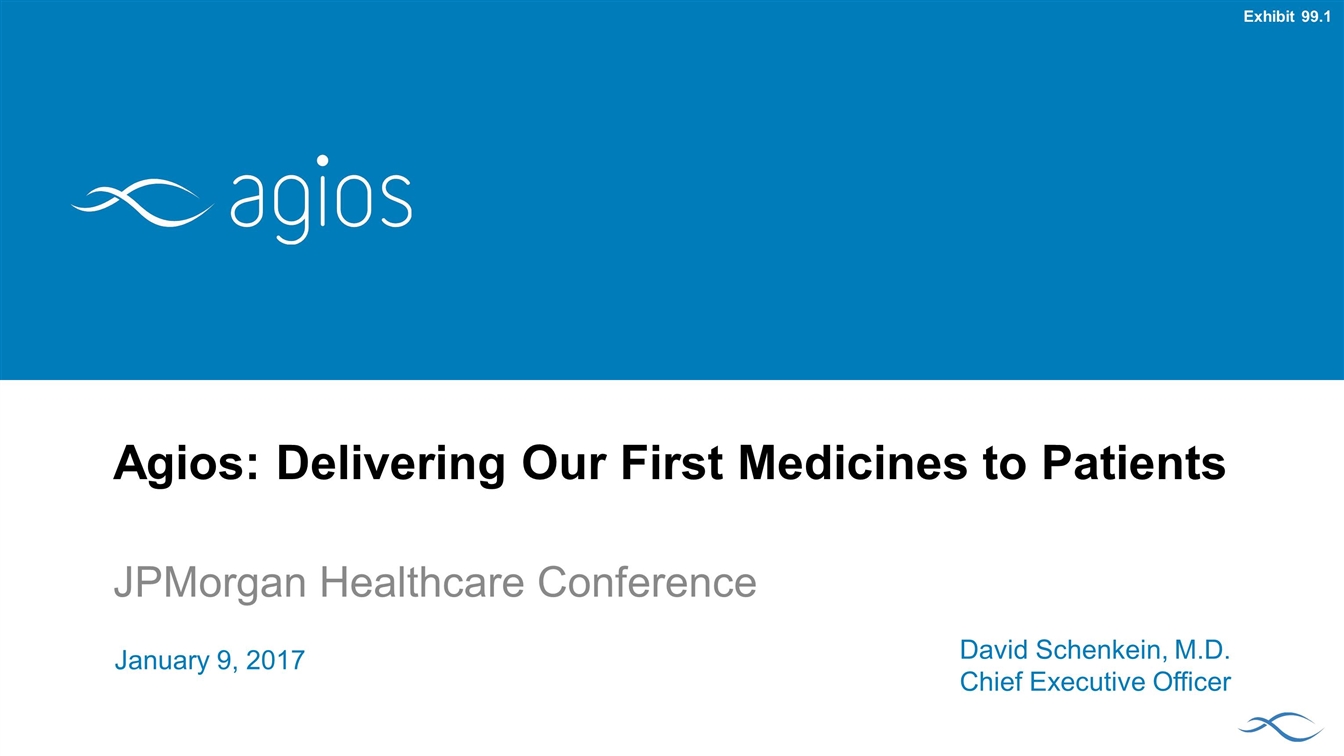
Agios: Delivering Our First Medicines to Patients JPMorgan Healthcare Conference David Schenkein, M.D. Chief Executive Officer January 9, 2017 Exhibit 99.1
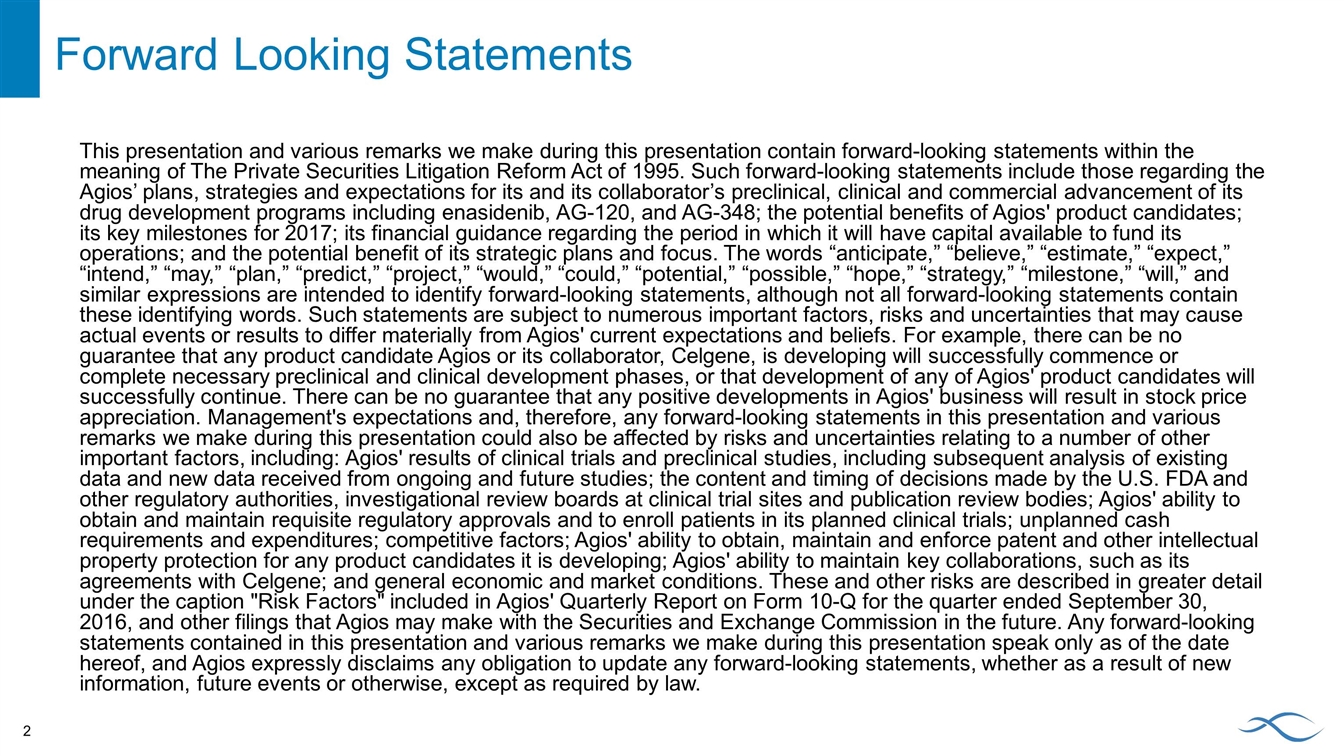
Forward Looking Statements This presentation and various remarks we make during this presentation contain forward-looking statements within the meaning of The Private Securities Litigation Reform Act of 1995. Such forward-looking statements include those regarding the Agios’ plans, strategies and expectations for its and its collaborator’s preclinical, clinical and commercial advancement of its drug development programs including enasidenib, AG-120, and AG-348; the potential benefits of Agios' product candidates; its key milestones for 2017; its financial guidance regarding the period in which it will have capital available to fund its operations; and the potential benefit of its strategic plans and focus. The words “anticipate,” “believe,” “estimate,” “expect,” “intend,” “may,” “plan,” “predict,” “project,” “would,” “could,” “potential,” “possible,” “hope,” “strategy,” “milestone,” “will,” and similar expressions are intended to identify forward-looking statements, although not all forward-looking statements contain these identifying words. Such statements are subject to numerous important factors, risks and uncertainties that may cause actual events or results to differ materially from Agios' current expectations and beliefs. For example, there can be no guarantee that any product candidate Agios or its collaborator, Celgene, is developing will successfully commence or complete necessary preclinical and clinical development phases, or that development of any of Agios' product candidates will successfully continue. There can be no guarantee that any positive developments in Agios' business will result in stock price appreciation. Management's expectations and, therefore, any forward-looking statements in this presentation and various remarks we make during this presentation could also be affected by risks and uncertainties relating to a number of other important factors, including: Agios' results of clinical trials and preclinical studies, including subsequent analysis of existing data and new data received from ongoing and future studies; the content and timing of decisions made by the U.S. FDA and other regulatory authorities, investigational review boards at clinical trial sites and publication review bodies; Agios' ability to obtain and maintain requisite regulatory approvals and to enroll patients in its planned clinical trials; unplanned cash requirements and expenditures; competitive factors; Agios' ability to obtain, maintain and enforce patent and other intellectual property protection for any product candidates it is developing; Agios' ability to maintain key collaborations, such as its agreements with Celgene; and general economic and market conditions. These and other risks are described in greater detail under the caption "Risk Factors" included in Agios' Quarterly Report on Form 10-Q for the quarter ended September 30, 2016, and other filings that Agios may make with the Securities and Exchange Commission in the future. Any forward-looking statements contained in this presentation and various remarks we make during this presentation speak only as of the date hereof, and Agios expressly disclaims any obligation to update any forward-looking statements, whether as a result of new information, future events or otherwise, except as required by law.
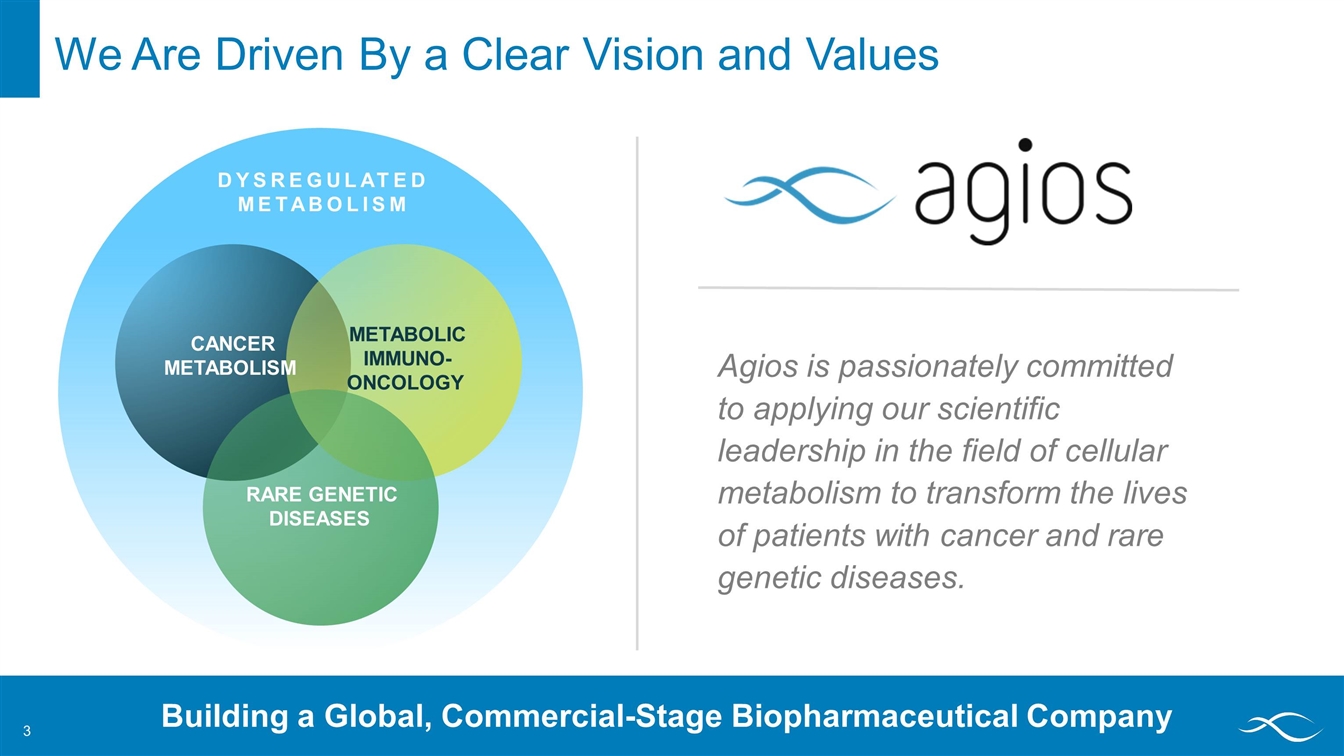
Agios is passionately committed to applying our scientific leadership in the field of cellular metabolism to transform the lives of patients with cancer and rare genetic diseases. We Are Driven By a Clear Vision and Values CANCER METABOLISM METABOLIC IMMUNO-ONCOLOGY RARE GENETIC DISEASES DYSREGULATED METABOLISM Building a Global, Commercial-Stage Biopharmaceutical Company

January 2009 5
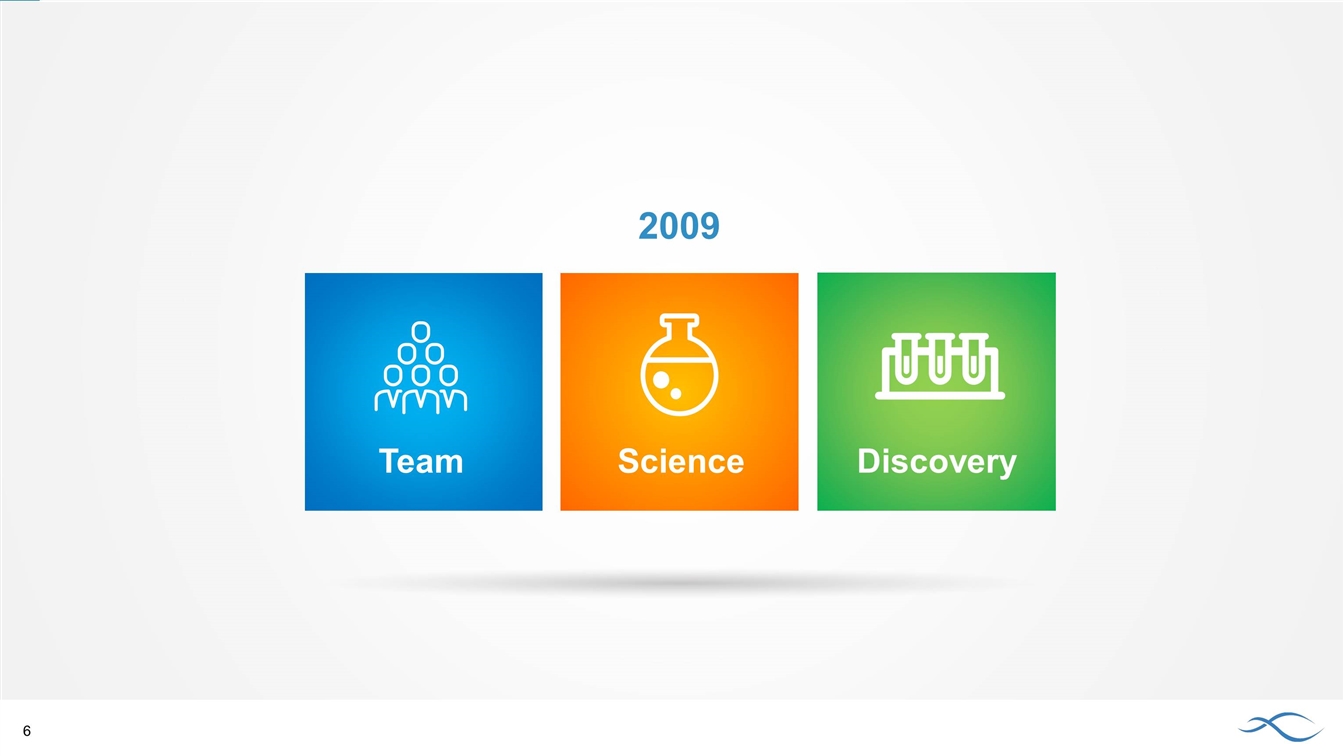
Science Team Discovery 2009 6
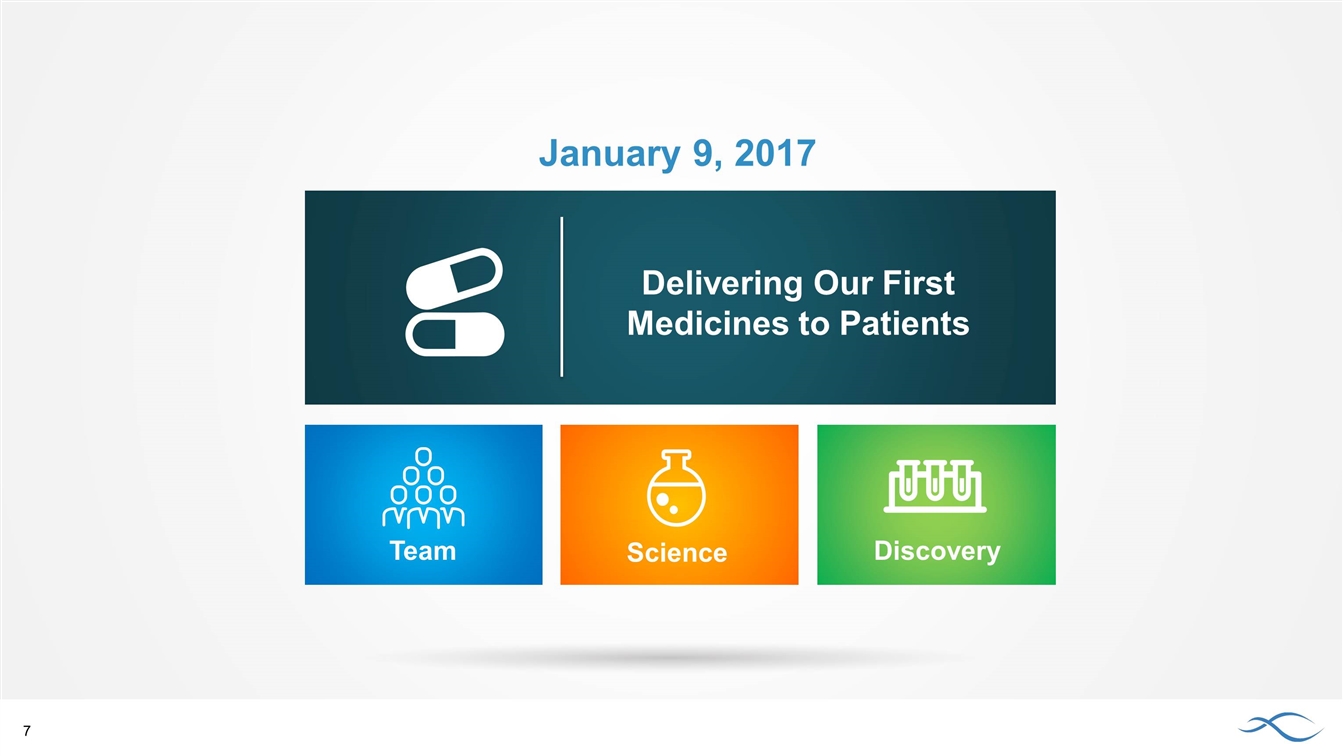
January 9, 2017 Delivering Our First Medicines to Patients Science Team Discovery 7
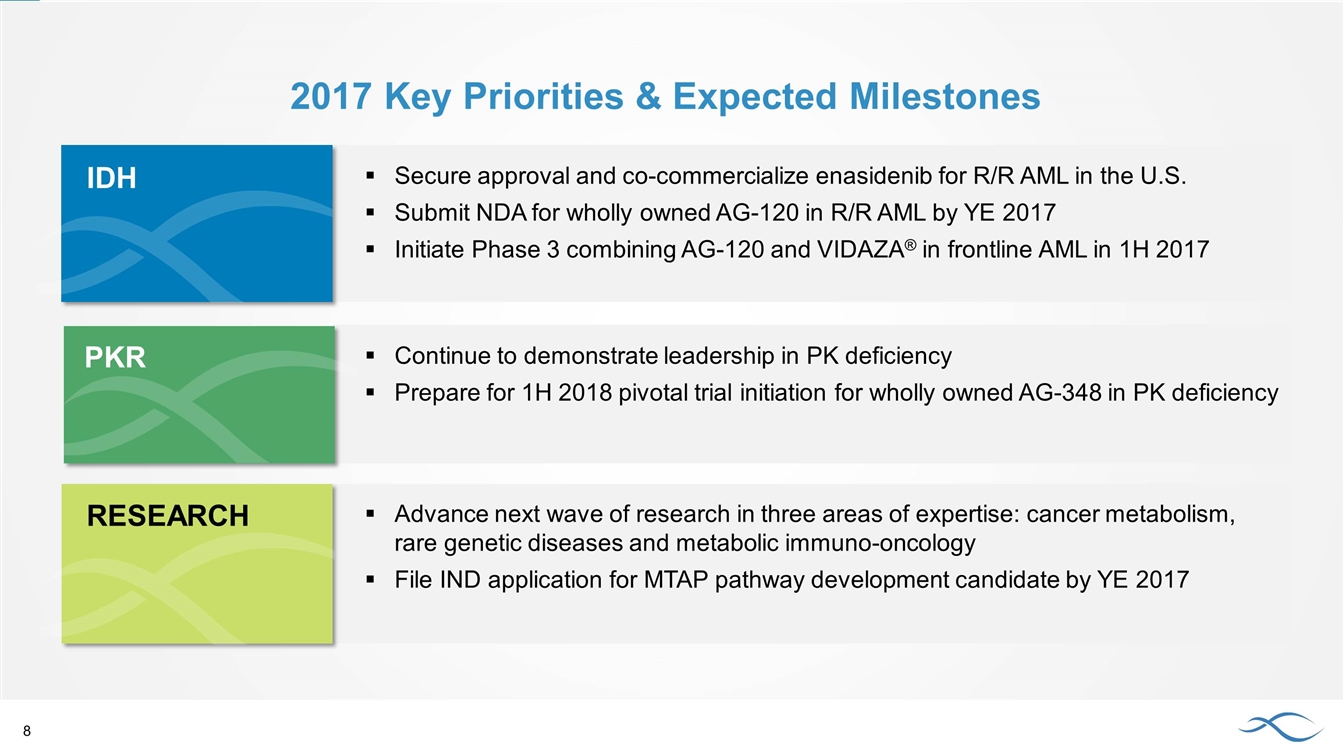
PKR Continue to demonstrate leadership in PK deficiency Prepare for 1H 2018 pivotal trial initiation for wholly owned AG-348 in PK deficiency IDH Secure approval and co-commercialize enasidenib for R/R AML in the U.S. Submit NDA for wholly owned AG-120 in R/R AML by YE 2017 Initiate Phase 3 combining AG-120 and VIDAZA® in frontline AML in 1H 2017 Advance next wave of research in three areas of expertise: cancer metabolism, rare genetic diseases and metabolic immuno-oncology File IND application for MTAP pathway development candidate by YE 2017 RESEARCH 2017 Key Priorities & Expected Milestones 8
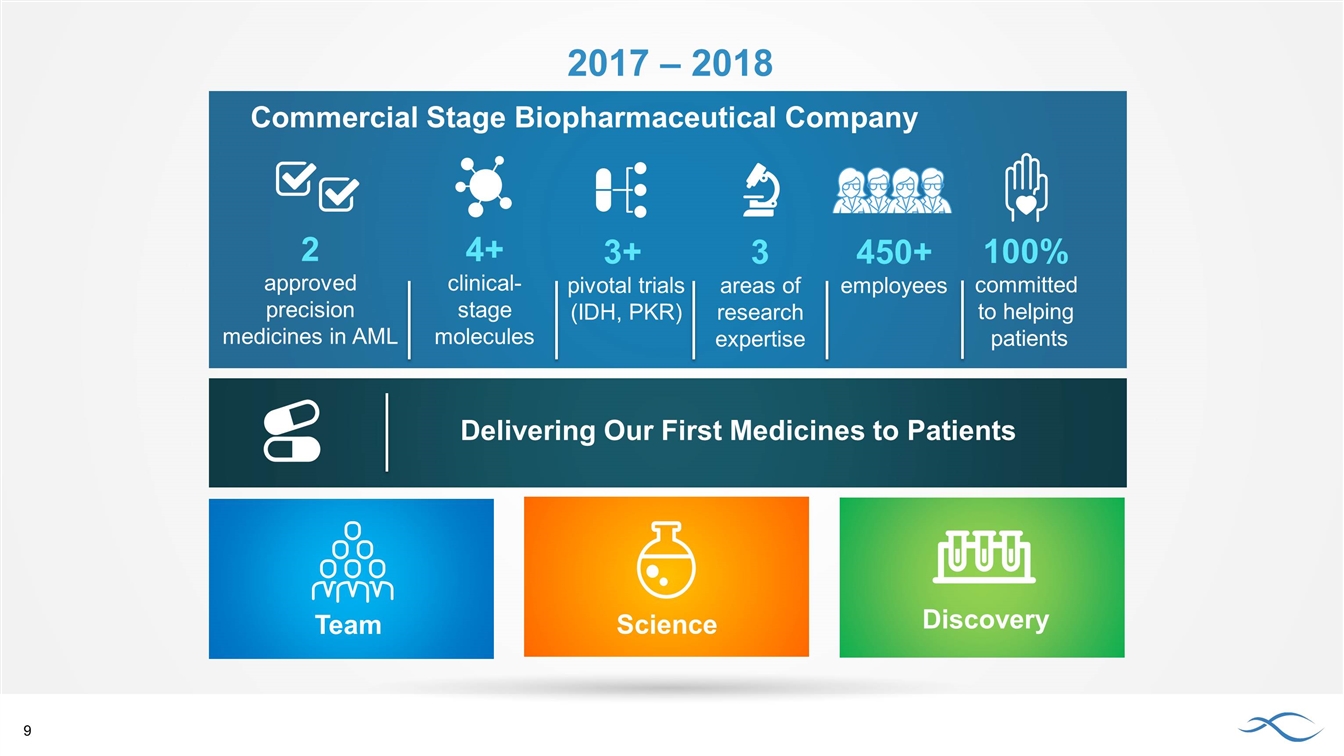
Delivering Our First Medicines to Patients Commercial Stage Biopharmaceutical Company Science Team Discovery 450+ employees 2 approved precision medicines in AML 2017 – 2018 4+ clinical-stage molecules 3+ pivotal trials (IDH, PKR) 100% committed to helping patients 3 areas of research expertise 9
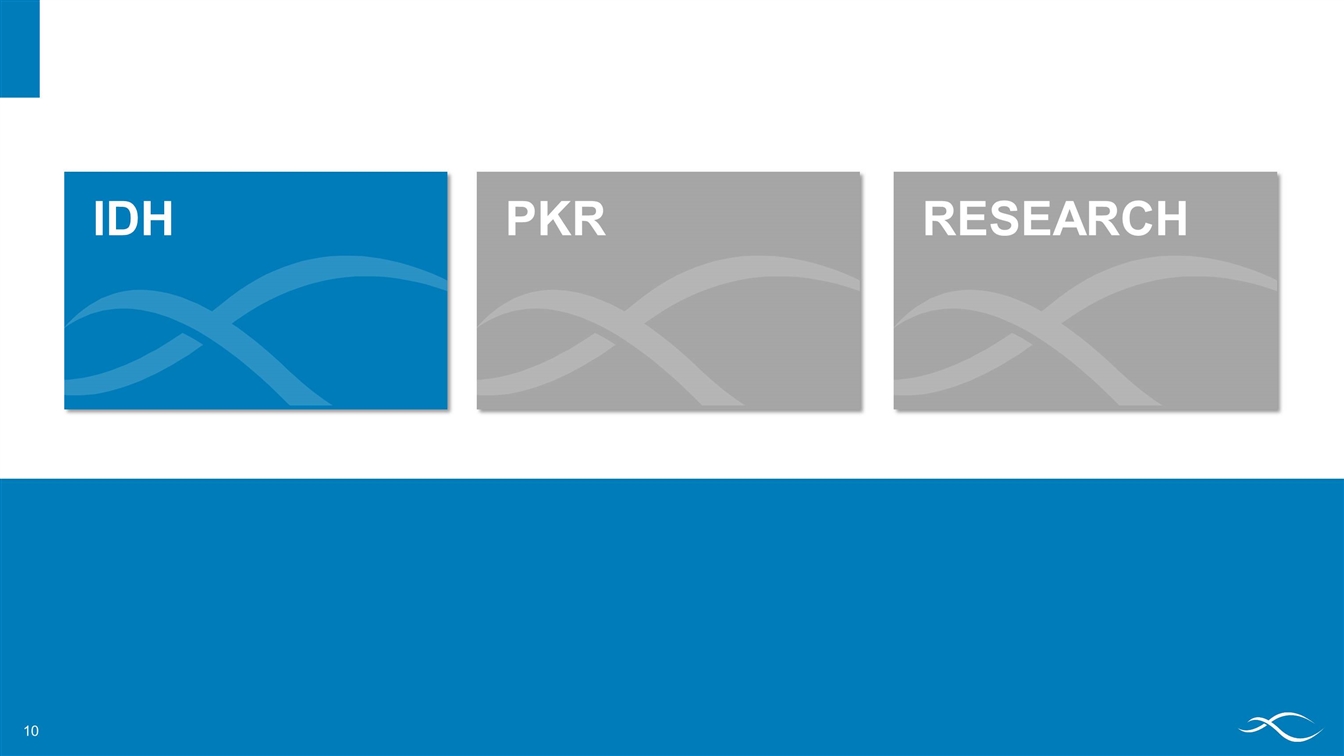
IDH PKR RESEARCH 10
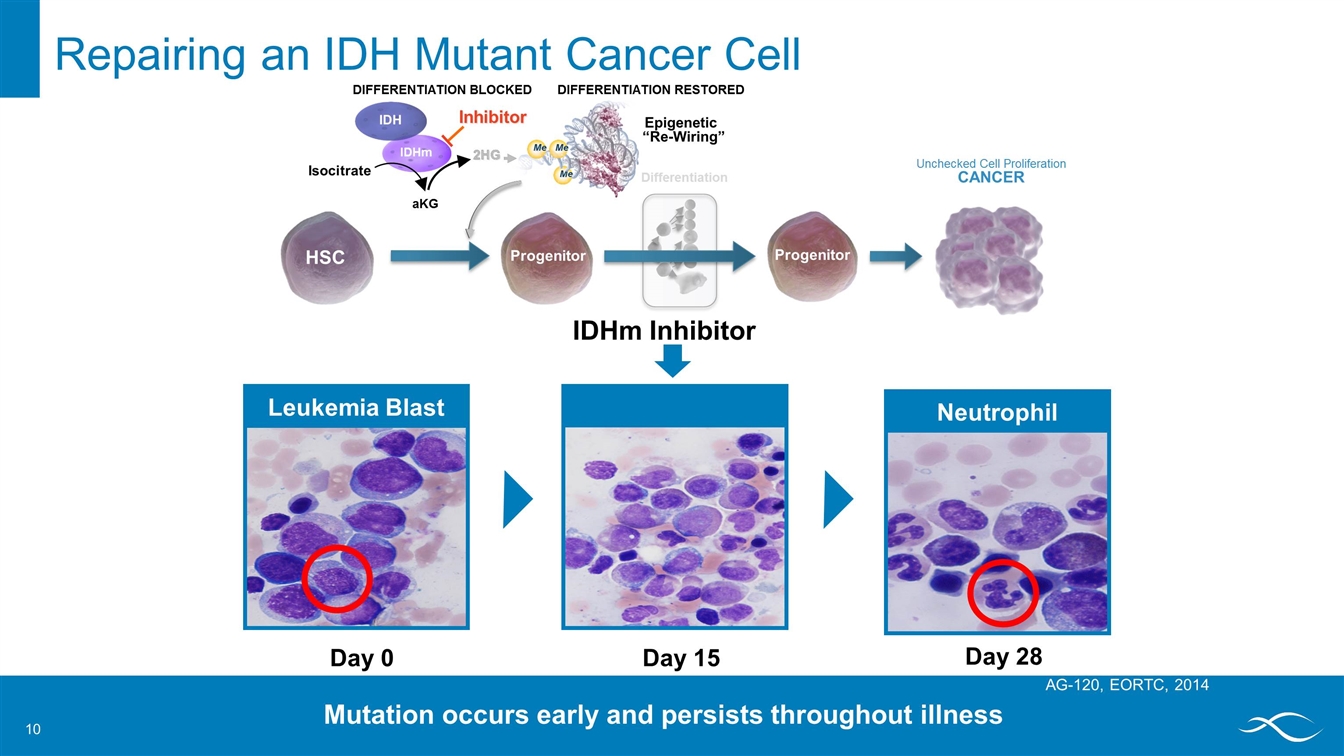
Repairing an IDH Mutant Cancer Cell IDHm Inhibitor Differentiation Mature Cell Normal Cell Death / HOMEOSTASIS Differentiation Progenitor Unchecked Cell Proliferation CANCER HSC Progenitor DIFFERENTIATION BLOCKED Me Me Me IDHm IDH Isocitrate aKG 2HG Epigenetic “Re-Wiring” Inhibitor 2HG Day 15 Day 28 Neutrophil Day 0 Leukemia Blast AG-120, EORTC, 2014 Mutation occurs early and persists throughout illness DIFFERENTIATION RESTORED
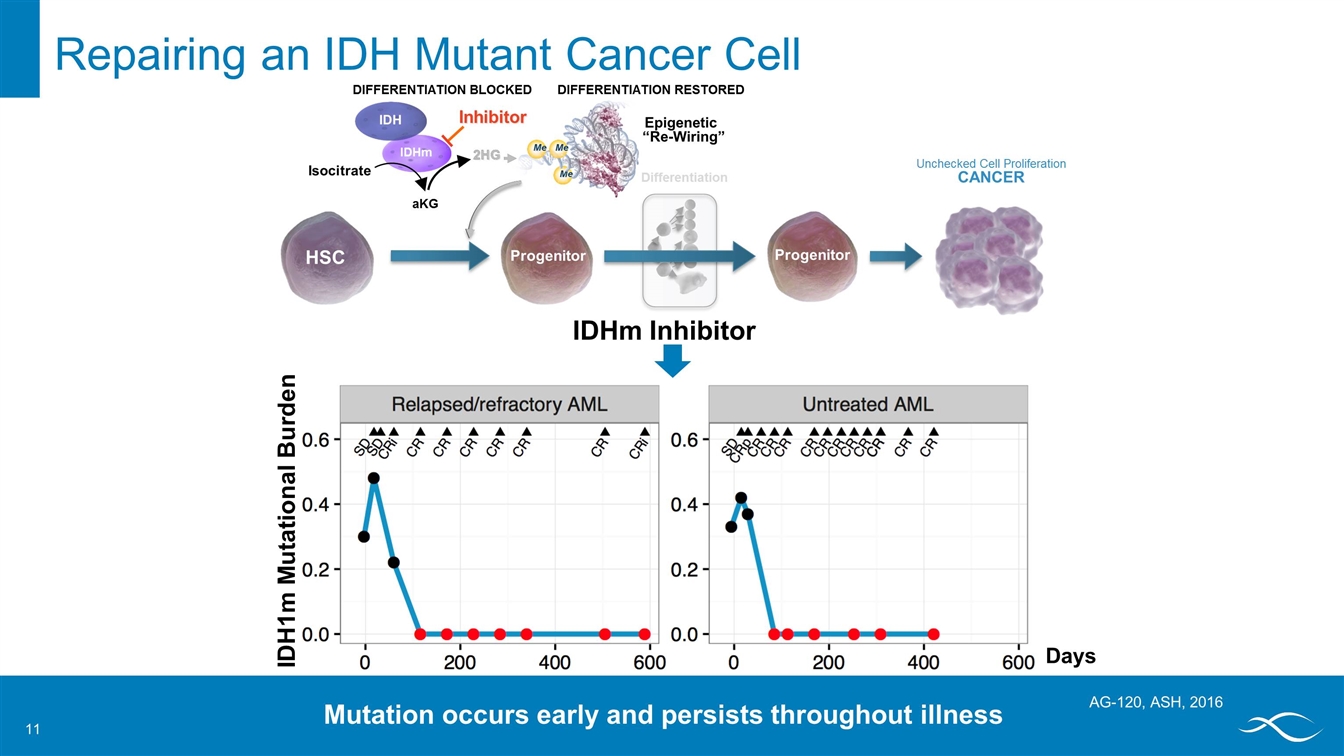
Repairing an IDH Mutant Cancer Cell IDHm Inhibitor Differentiation Mature Cell Normal Cell Death / HOMEOSTASIS Differentiation Progenitor Unchecked Cell Proliferation CANCER HSC Progenitor DIFFERENTIATION BLOCKED Me Me Me IDHm IDH Isocitrate aKG 2HG Epigenetic “Re-Wiring” Inhibitor 2HG AG-120, ASH, 2016 IDH1m Mutational Burden Mutation occurs early and persists throughout illness Days DIFFERENTIATION RESTORED
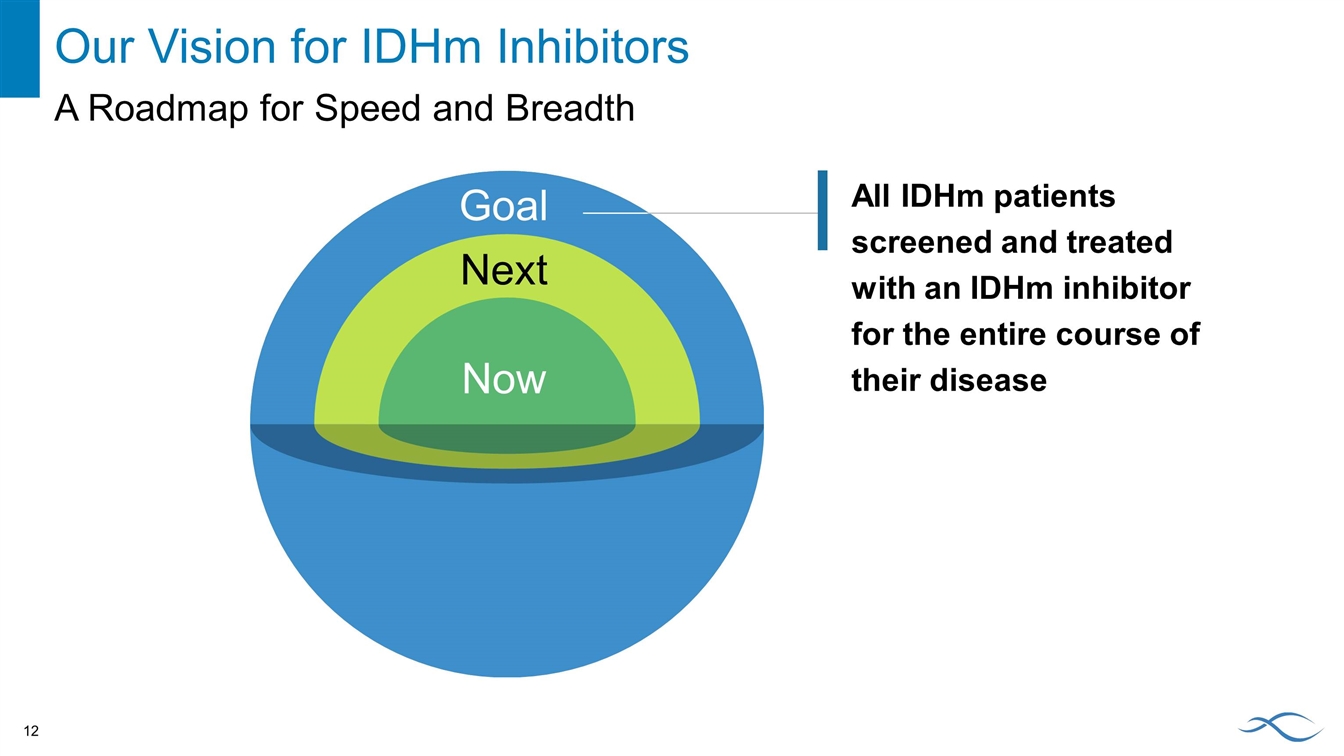
Goal All IDHm patients screened and treated with an IDHm inhibitor for the entire course of their disease Our Vision for IDHm Inhibitors A Roadmap for Speed and Breadth Now Next
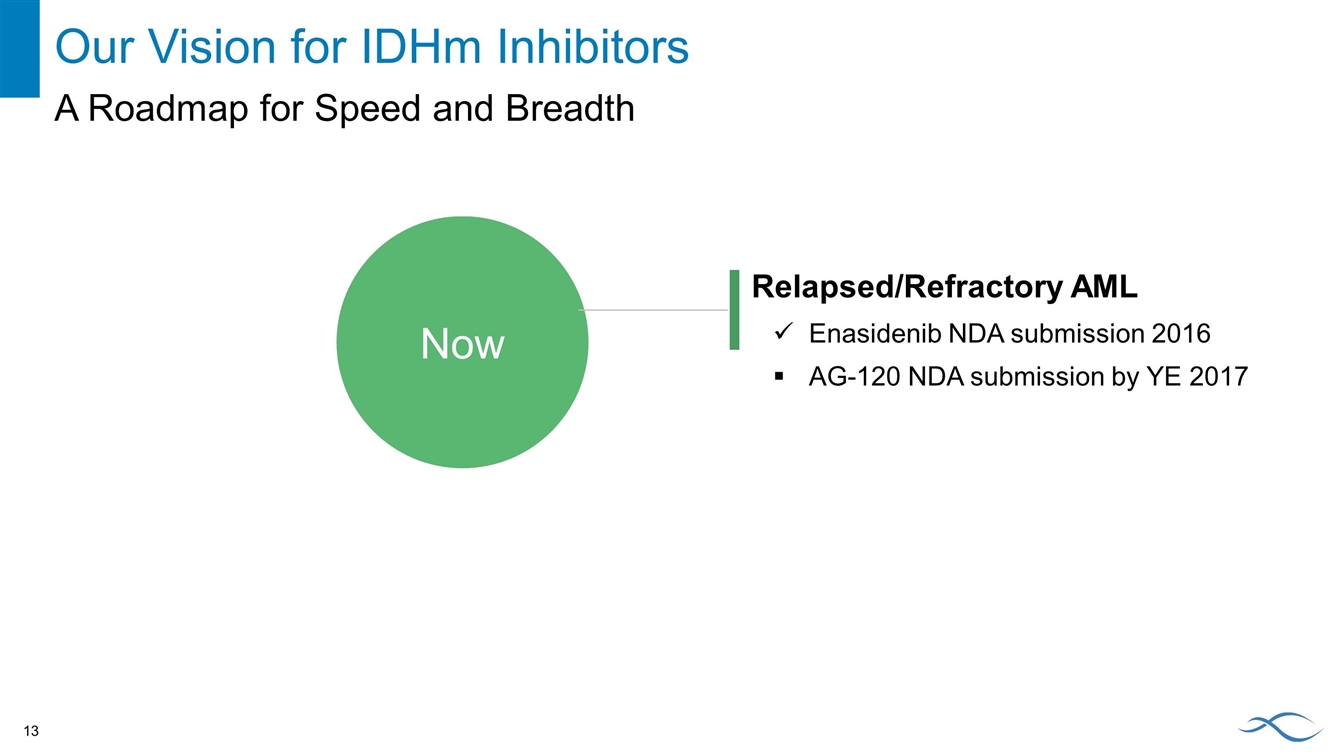
Now Next Goal Now Relapsed/Refractory AML Enasidenib NDA submission 2016 AG-120 NDA submission by YE 2017 Our Vision for IDHm Inhibitors A Roadmap for Speed and Breadth
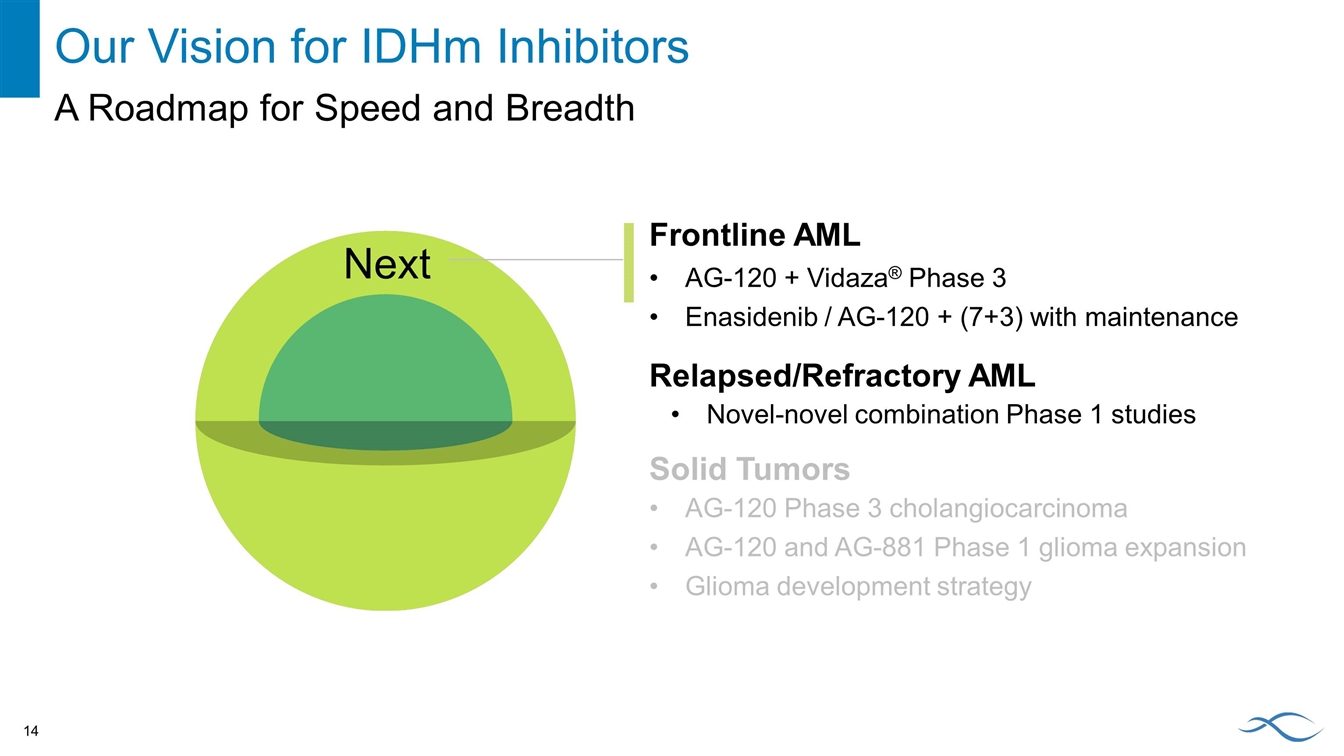
Next Frontline AML AG-120 + Vidaza® Phase 3 Enasidenib / AG-120 + (7+3) with maintenance Relapsed/Refractory AML Novel-novel combination Phase 1 studies Solid Tumors AG-120 Phase 3 cholangiocarcinoma AG-120 and AG-881 Phase 1 glioma expansion Glioma development strategy Our Vision for IDHm Inhibitors A Roadmap for Speed and Breadth
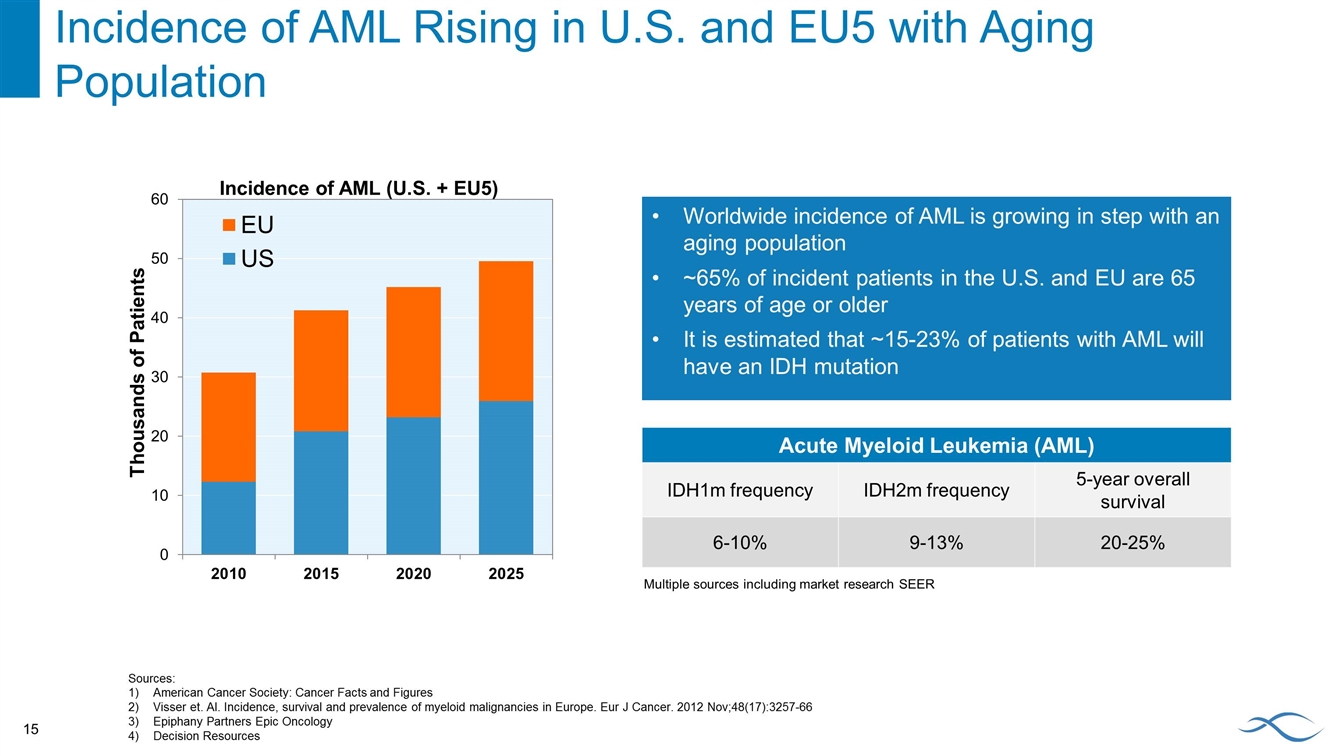
Incidence of AML Rising in U.S. and EU5 with Aging Population Sources: American Cancer Society: Cancer Facts and Figures Visser et. Al. Incidence, survival and prevalence of myeloid malignancies in Europe. Eur J Cancer. 2012 Nov;48(17):3257-66 Epiphany Partners Epic Oncology Decision Resources Thousands of Patients Incidence of AML (U.S. + EU5) Worldwide incidence of AML is growing in step with an aging population ~65% of incident patients in the U.S. and EU are 65 years of age or older It is estimated that ~15-23% of patients with AML will have an IDH mutation Acute Myeloid Leukemia (AML) IDH1m frequency IDH2m frequency 5-year overall survival 6-10% 9-13% 20-25% Multiple sources including market research SEER 15
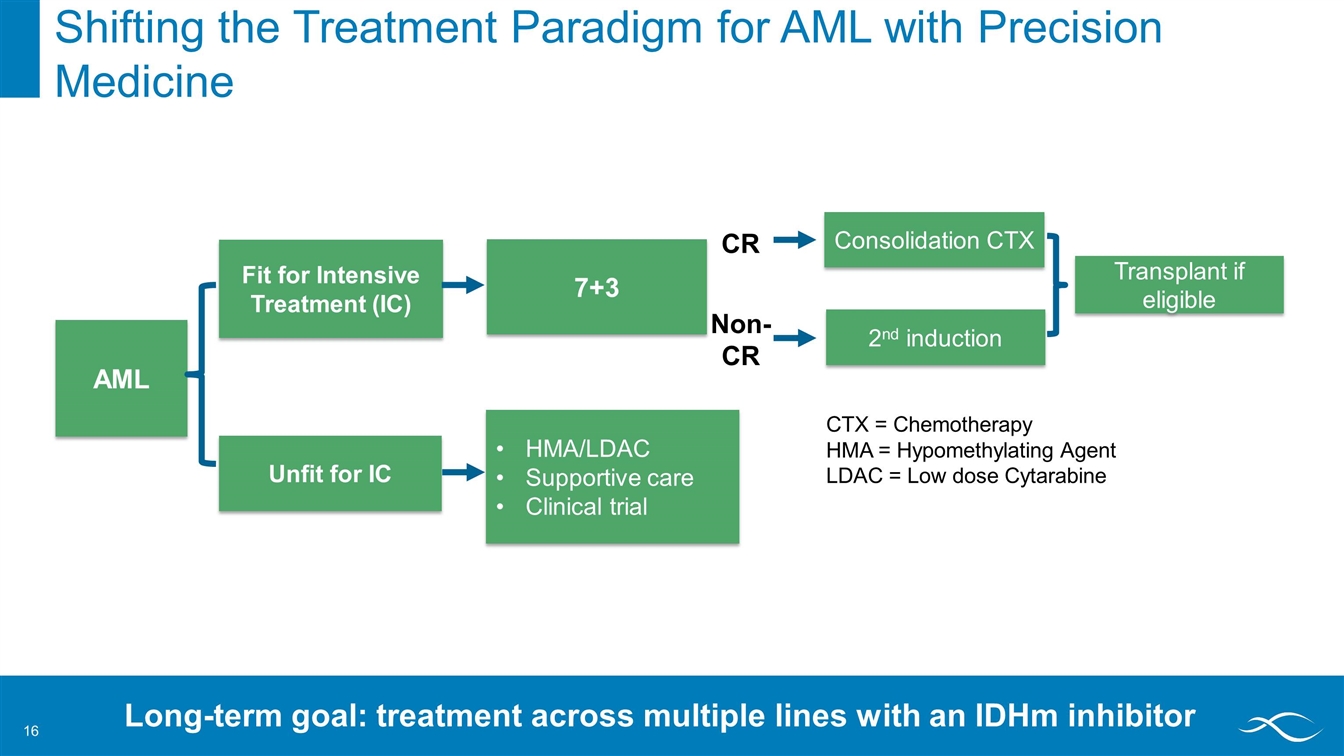
AML Fit for Intensive Treatment (IC) Unfit for IC 7+3 HMA/LDAC Supportive care Clinical trial CR Non-CR Consolidation CTX 2nd induction Transplant if eligible CTX = Chemotherapy HMA = Hypomethylating Agent LDAC = Low dose Cytarabine Shifting the Treatment Paradigm for AML with Precision Medicine Long-term goal: treatment across multiple lines with an IDHm inhibitor
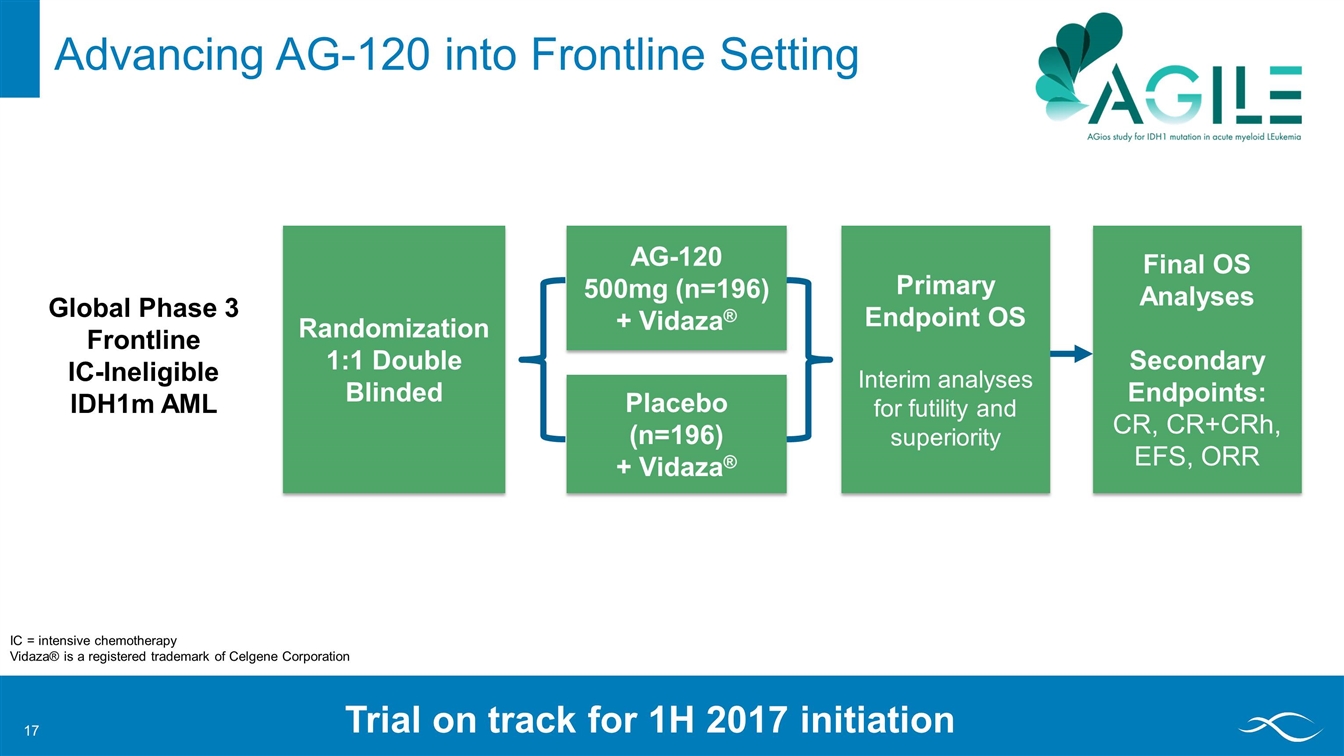
Randomization 1:1 Double Blinded AG-120 500mg (n=196) + Vidaza® Primary Endpoint OS Interim analyses for futility and superiority Advancing AG-120 into Frontline Setting Placebo (n=196) + Vidaza® Final OS Analyses Secondary Endpoints: CR, CR+CRh, EFS, ORR Trial on track for 1H 2017 initiation Global Phase 3 Frontline IC-Ineligible IDH1m AML IC = intensive chemotherapy Vidaza® is a registered trademark of Celgene Corporation
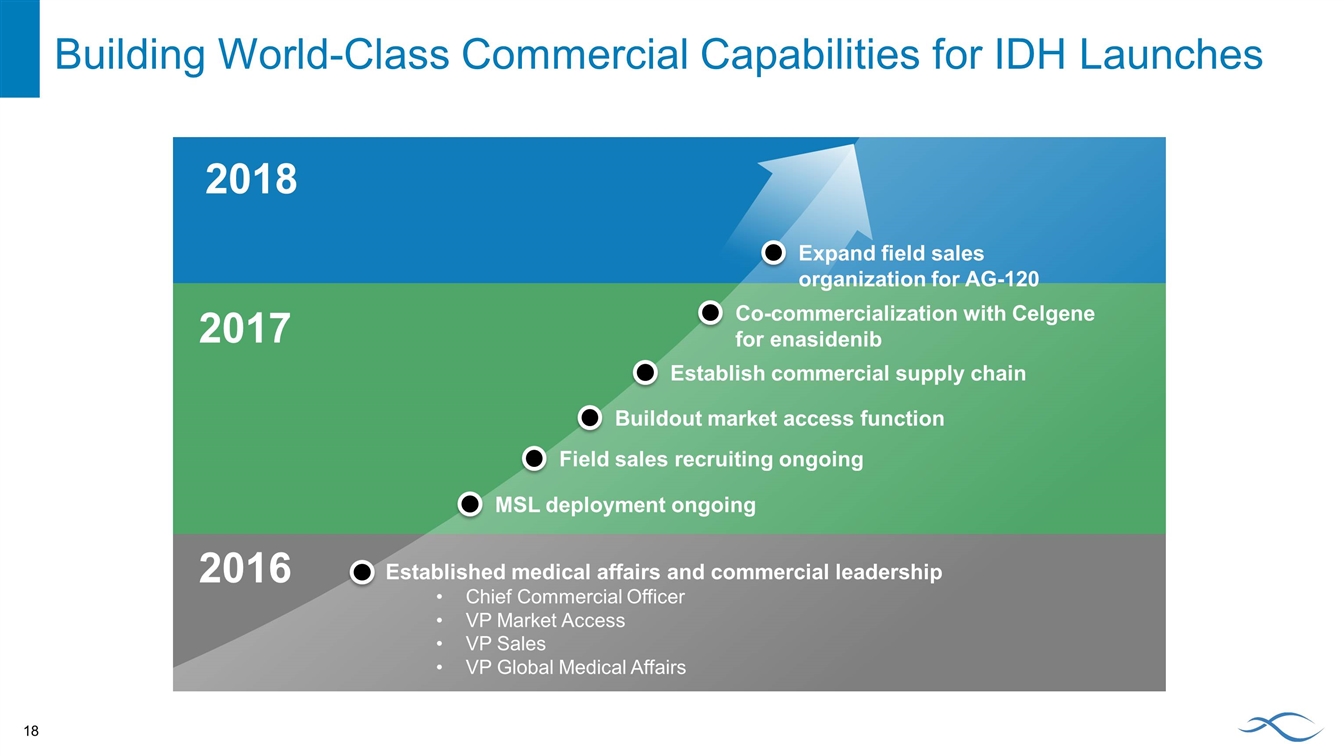
2017 2016 Building World-Class Commercial Capabilities for IDH Launches 2018 Co-commercialization with Celgene for enasidenib Established medical affairs and commercial leadership Chief Commercial Officer VP Market Access VP Sales VP Global Medical Affairs MSL deployment ongoing Field sales recruiting ongoing Buildout market access function Establish commercial supply chain Expand field sales organization for AG-120 18
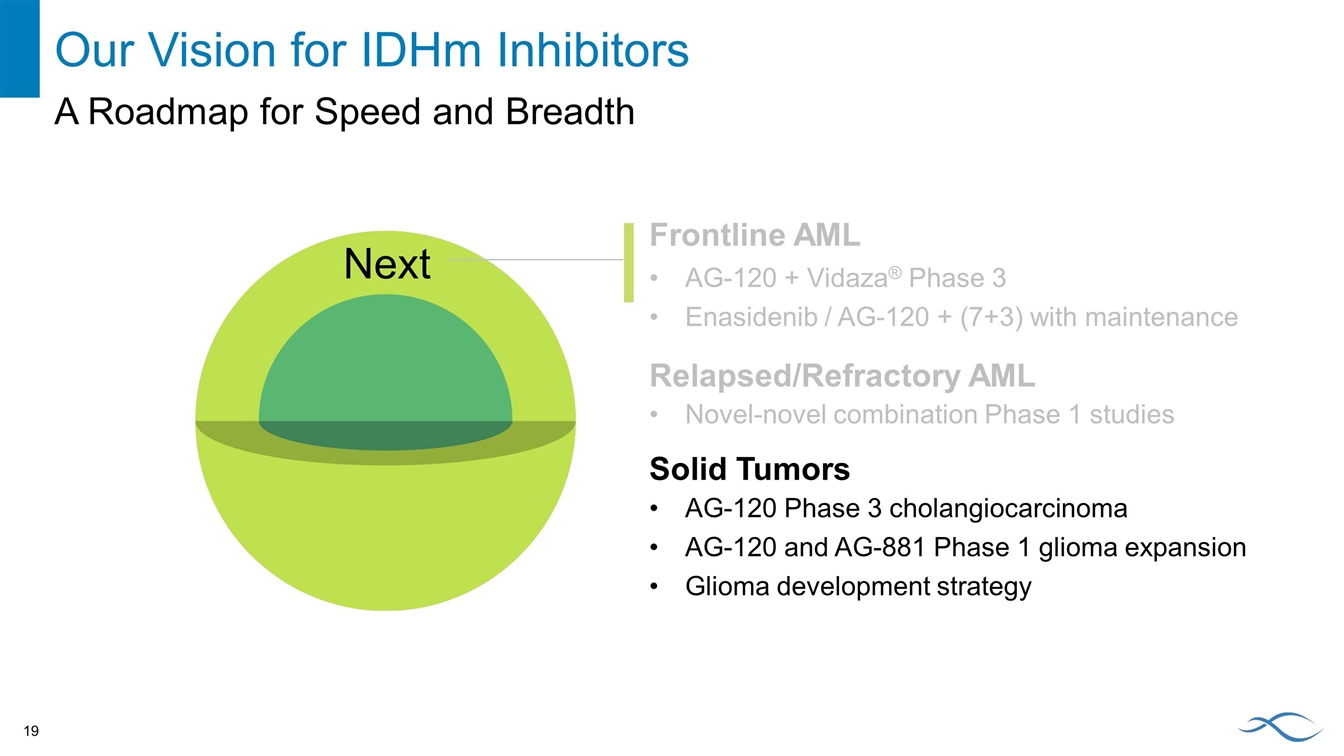
Next Frontline AML AG-120 + Vidaza® Phase 3 Enasidenib / AG-120 + (7+3) with maintenance Relapsed/Refractory AML Novel-novel combination Phase 1 studies Solid Tumors AG-120 Phase 3 cholangiocarcinoma AG-120 and AG-881 Phase 1 glioma expansion Glioma development strategy Our Vision for IDHm Inhibitors A Roadmap for Speed and Breadth
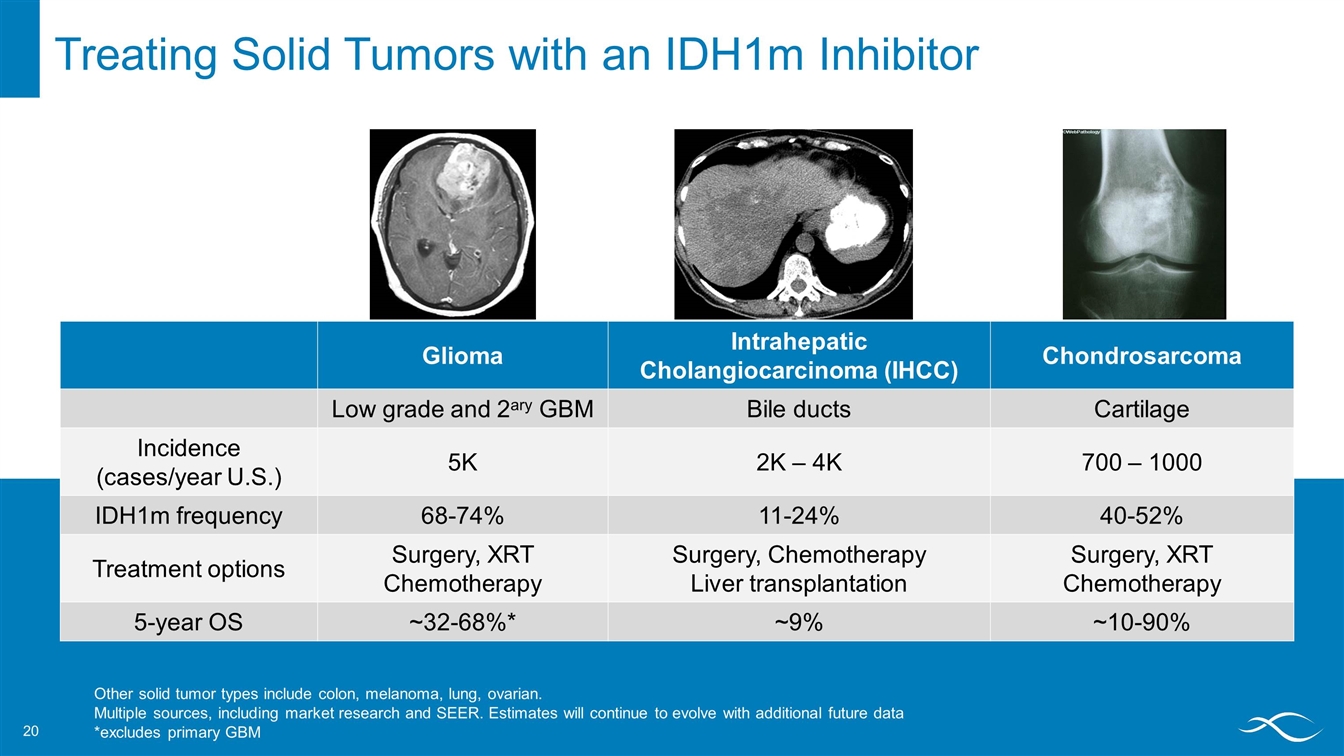
Other solid tumor types include colon, melanoma, lung, ovarian. Multiple sources, including market research and SEER. Estimates will continue to evolve with additional future data *excludes primary GBM Treating Solid Tumors with an IDH1m Inhibitor Glioma Intrahepatic Cholangiocarcinoma (IHCC) Chondrosarcoma Low grade and 2ary GBM Bile ducts Cartilage Incidence (cases/year U.S.) 5K 2K – 4K 700 – 1000 IDH1m frequency 68-74% 11-24% 40-52% Treatment options Surgery, XRT Chemotherapy Surgery, Chemotherapy Liver transplantation Surgery, XRT Chemotherapy 5-year OS ~32-68%* ~9% ~10-90%
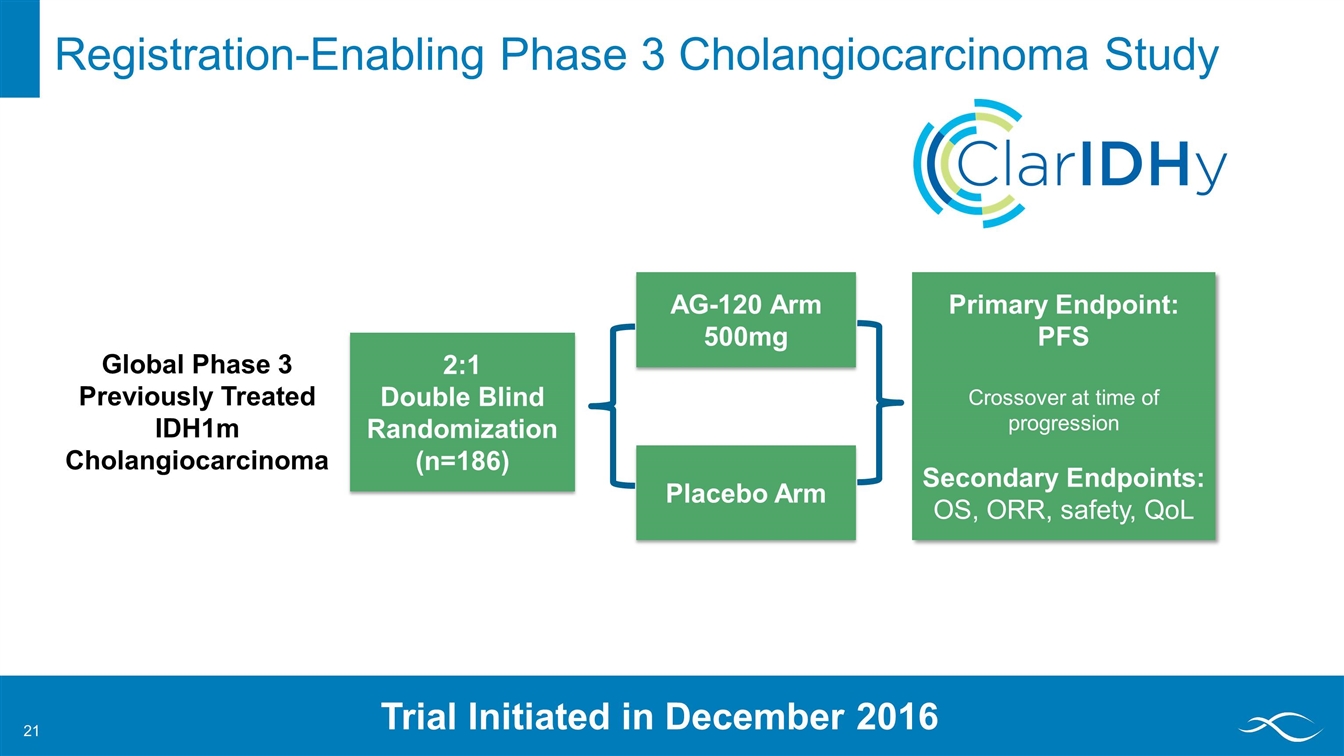
2:1 Double Blind Randomization (n=186) AG-120 Arm 500mg Registration-Enabling Phase 3 Cholangiocarcinoma Study Placebo Arm Primary Endpoint: PFS Crossover at time of progression Secondary Endpoints: OS, ORR, safety, QoL Trial Initiated in December 2016 Global Phase 3 Previously Treated IDH1m Cholangiocarcinoma

Phase 1 Dose-Escalation and Expansion (Completed) Encouraging Data with AG-120 Supports Clinical Development of IDH1m Inhibitor in Glioma AG-120 IDH1m Inhibition AG-881 High CNS Penetration, Pan-IDHm Inhibition Phase 1 Dose-Escalation (Ongoing) Potential Expansion 22 AG-120 Data Presented at SNO 2016
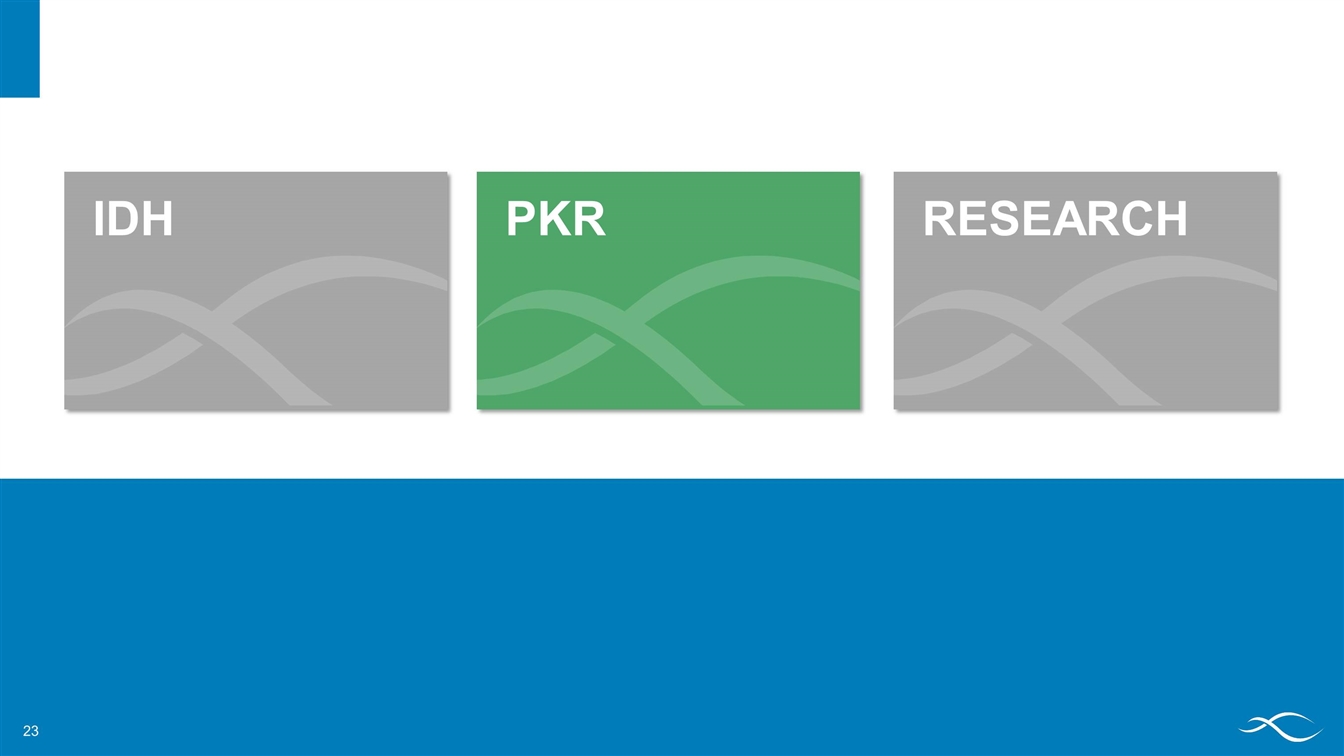
IDH PKR RESEARCH 23
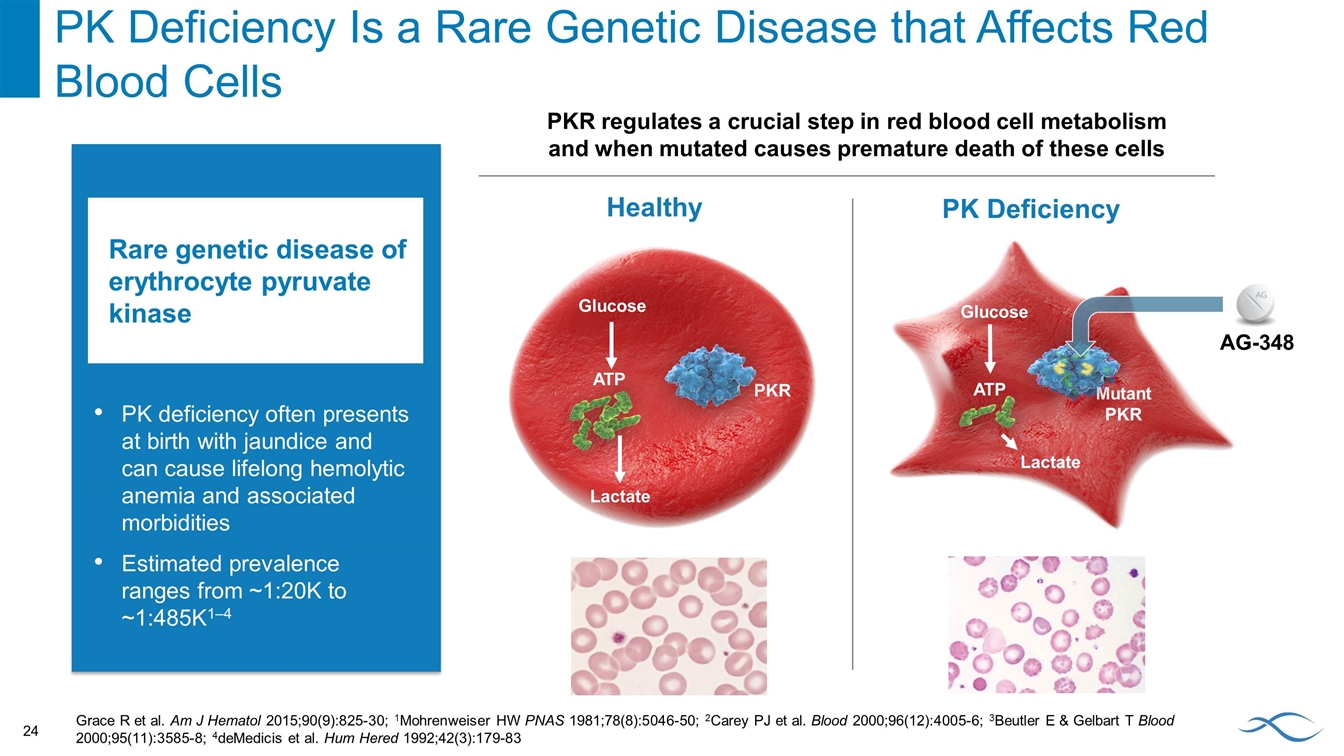
PK Deficiency Is a Rare Genetic Disease that Affects Red Blood Cells Rare genetic disease of erythrocyte pyruvate kinase PK deficiency often presents at birth with jaundice and can cause lifelong hemolytic anemia and associated morbidities Estimated prevalence ranges from ~1:20K to ~1:485K1–4 PKR regulates a crucial step in red blood cell metabolism and when mutated causes premature death of these cells Healthy PKR ATP Glucose PK Deficiency Mutant PKR ATP Glucose Grace R et al. Am J Hematol 2015;90(9):825-30; 1Mohrenweiser HW PNAS 1981;78(8):5046-50; 2Carey PJ et al. Blood 2000;96(12):4005-6; 3Beutler E & Gelbart T Blood 2000;95(11):3585-8; 4deMedicis et al. Hum Hered 1992;42(3):179-83 Lactate Lactate AG-348
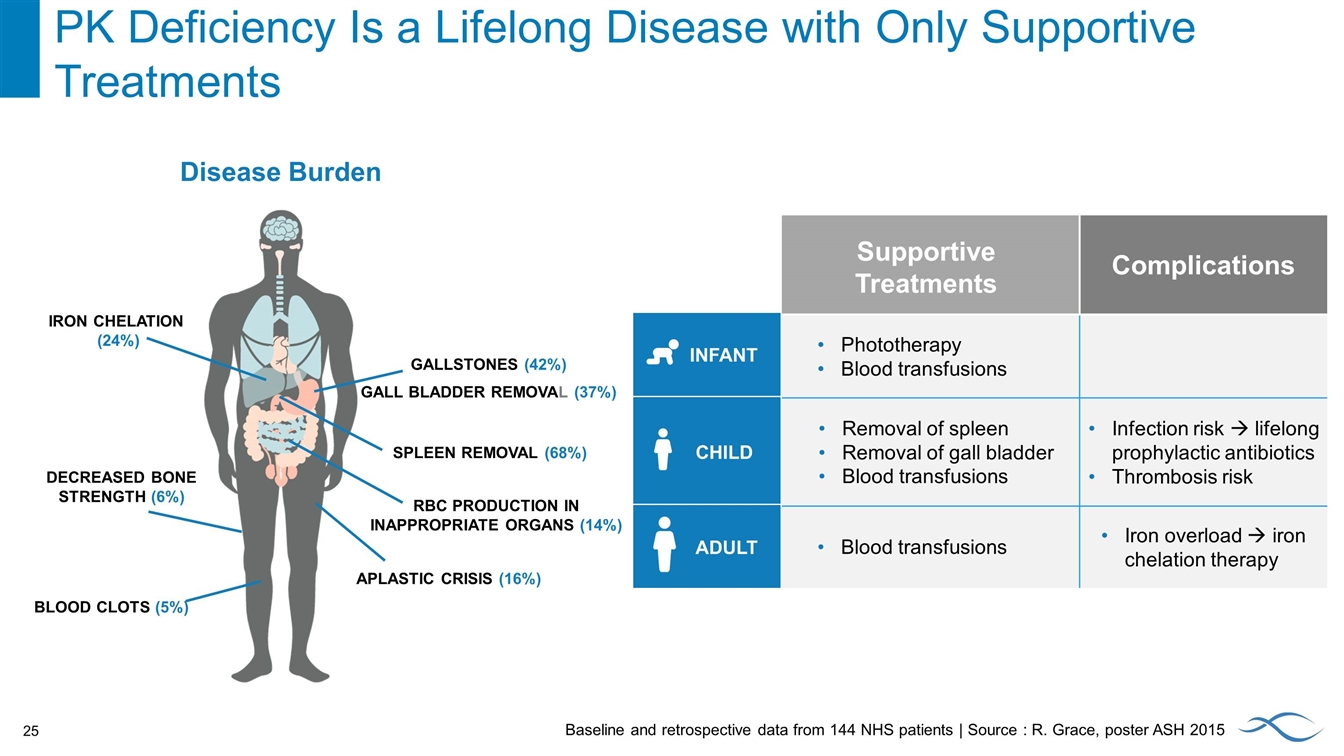
INFANT CHILD ADULT Supportive Treatments Complications Phototherapy Blood transfusions Removal of spleen Removal of gall bladder Blood transfusions Infection risk à lifelong prophylactic antibiotics Thrombosis risk Blood transfusions Iron overload à iron chelation therapy Disease Burden PK Deficiency Is a Lifelong Disease with Only Supportive Treatments IRON CHELATION (24%) GALLSTONES (42%) GALL BLADDER REMOVAL (37%) SPLEEN REMOVAL (68%) BLOOD CLOTS (5%) DECREASED BONE STRENGTH (6%) APLASTIC CRISIS (16%) RBC PRODUCTION IN INAPPROPRIATE ORGANS (14%) Baseline and retrospective data from 144 NHS patients | Source : R. Grace, poster ASH 2015
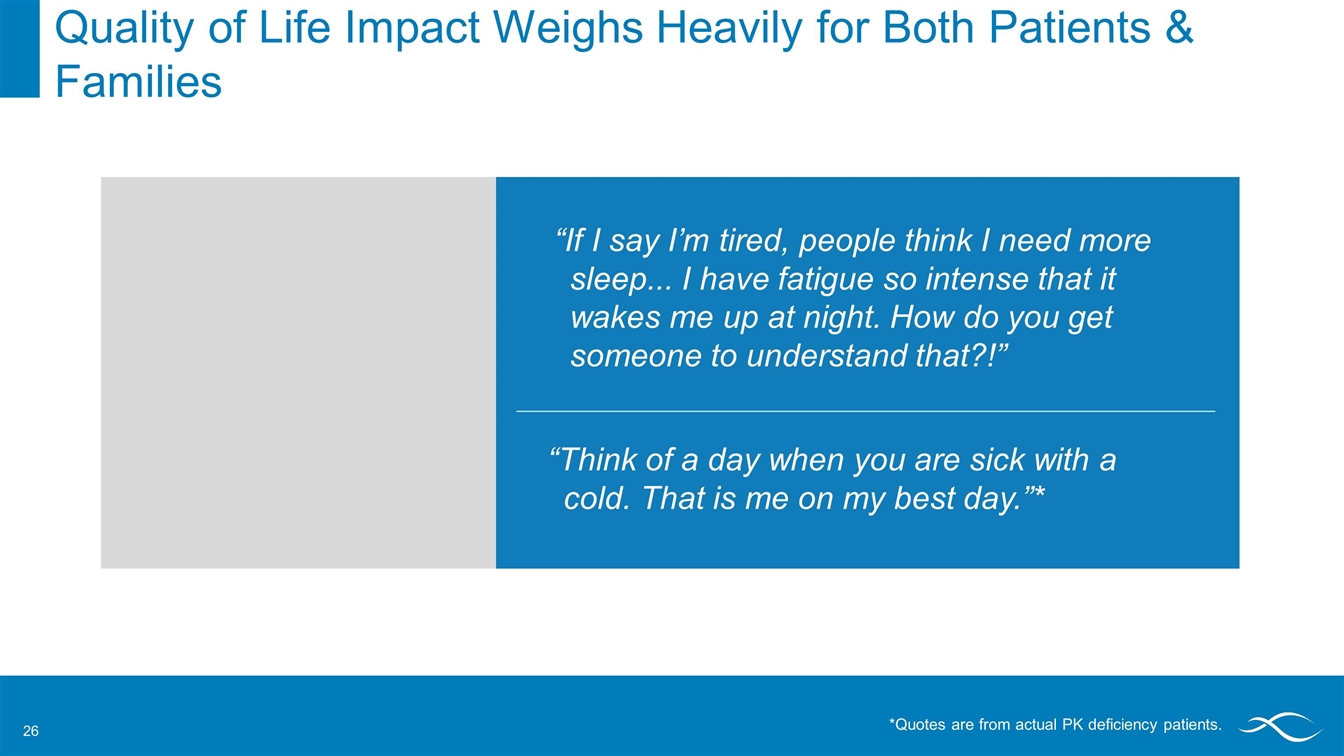
Quality of Life Impact Weighs Heavily for Both Patients & Families “If I say I’m tired, people think I need more sleep... I have fatigue so intense that it wakes me up at night. How do you get someone to understand that?!” “Think of a day when you are sick with a cold. That is me on my best day.”* *Quotes are from actual PK deficiency patients.
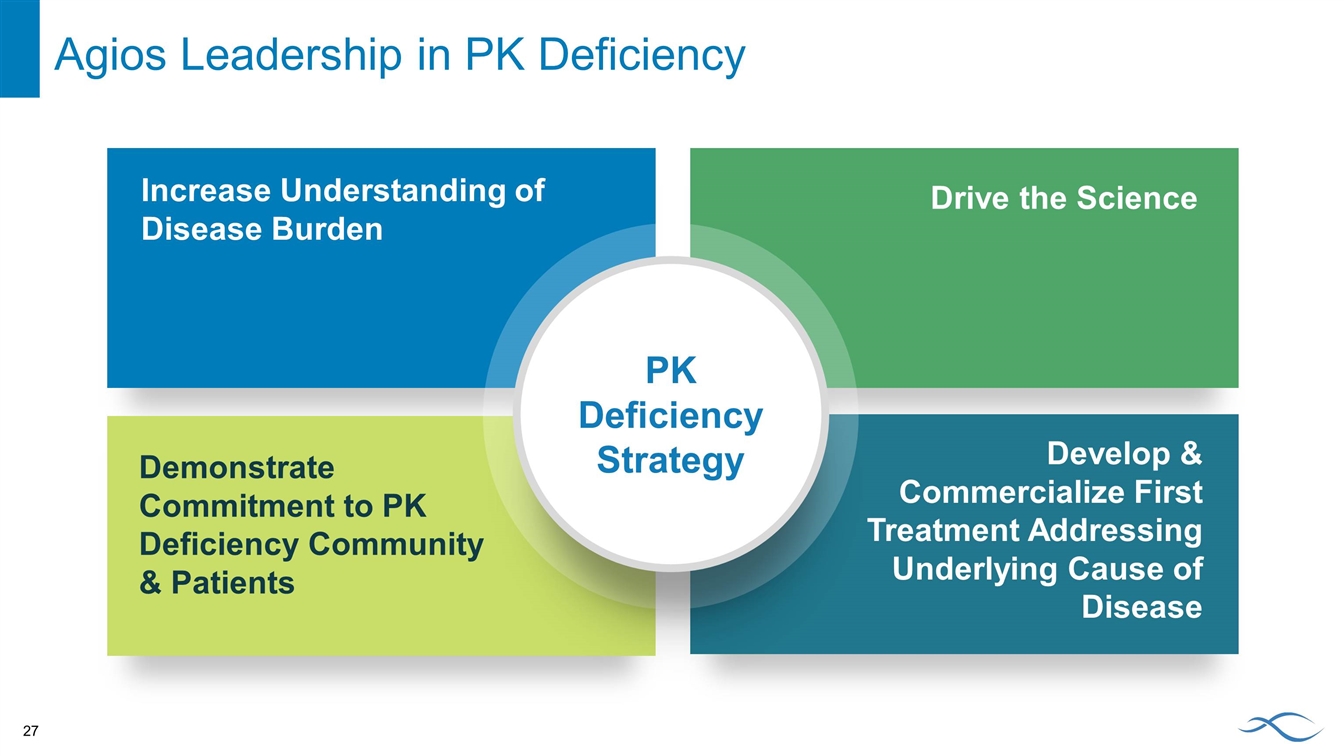
PK Deficiency Strategy Increase Understanding of Disease Burden Drive the Science Develop & Commercialize First Treatment Addressing Underlying Cause of Disease Demonstrate Commitment to PK Deficiency Community & Patients Agios Leadership in PK Deficiency
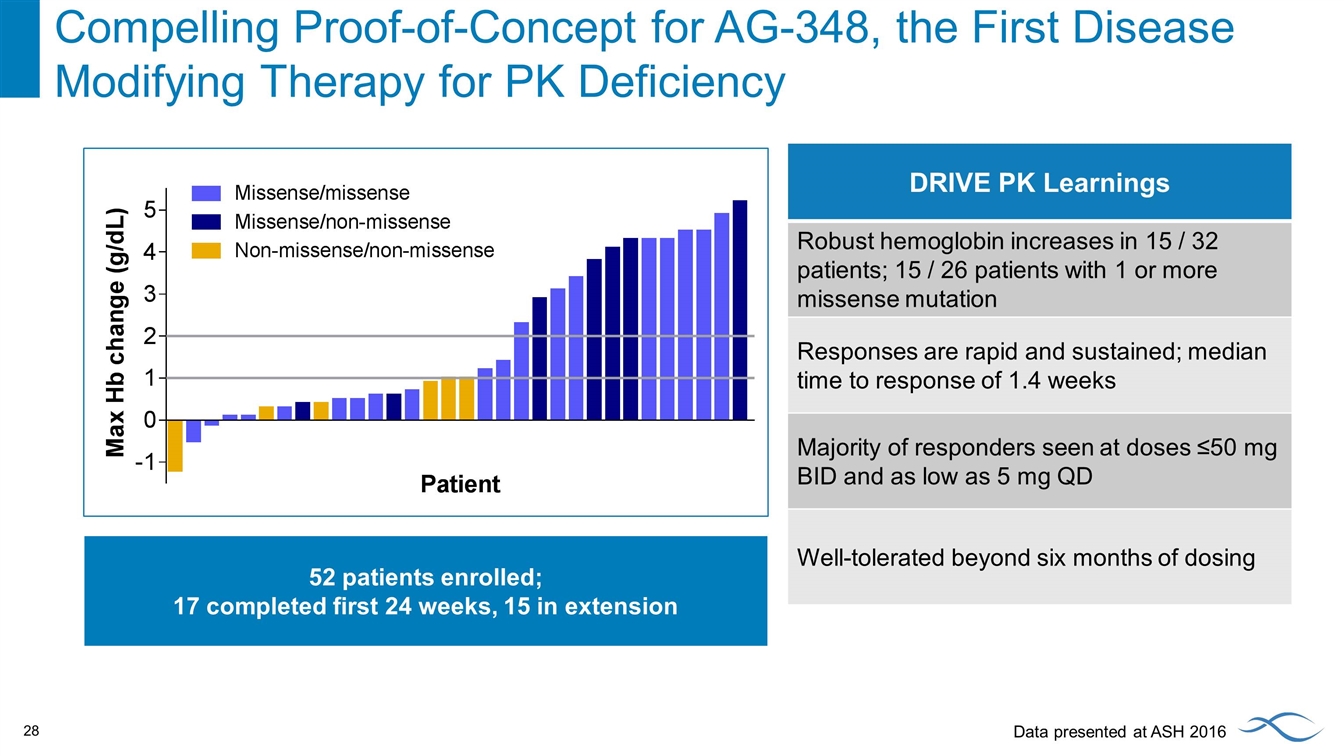
Compelling Proof-of-Concept for AG-348, the First Disease Modifying Therapy for PK Deficiency DRIVE PK Learnings Robust hemoglobin increases in 15 / 32 patients; 15 / 26 patients with 1 or more missense mutation Responses are rapid and sustained; median time to response of 1.4 weeks Majority of responders seen at doses ≤50 mg BID and as low as 5 mg QD Well-tolerated beyond six months of dosing Data presented at ASH 2016 52 patients enrolled; 17 completed first 24 weeks, 15 in extension
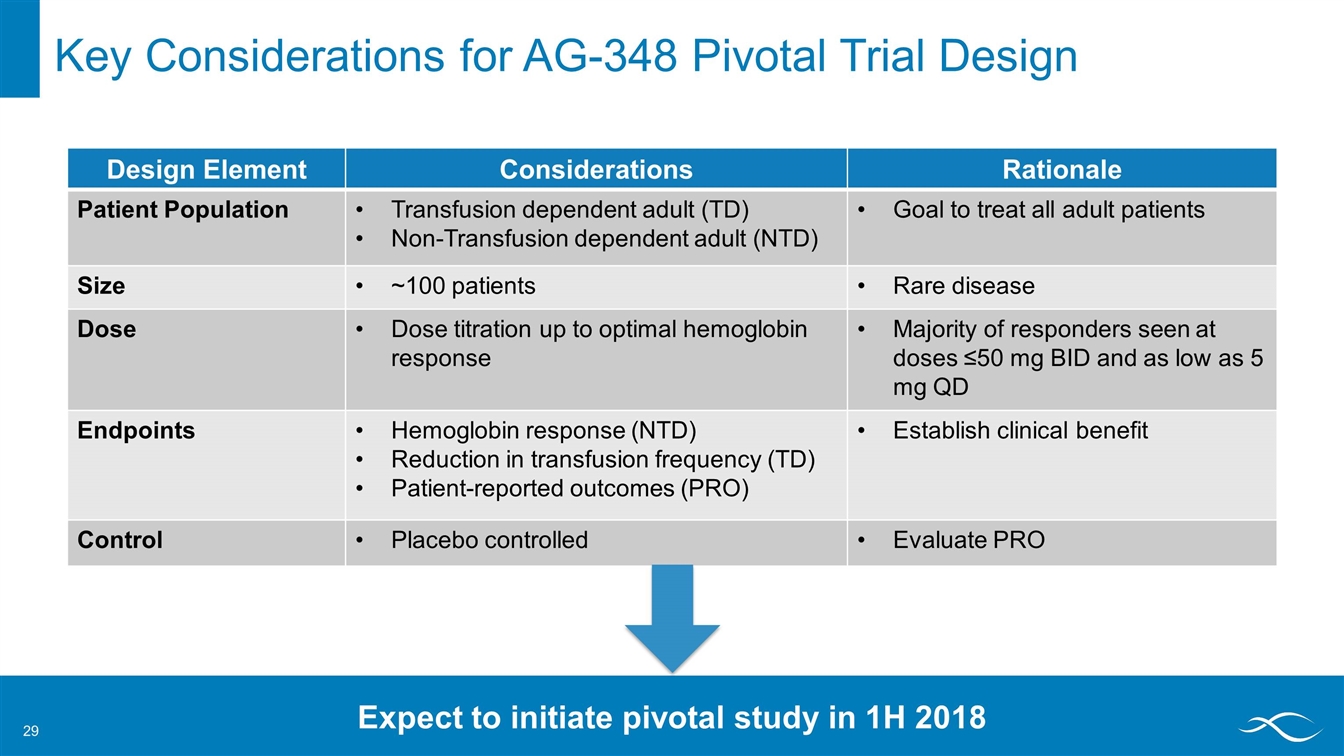
Key Considerations for AG-348 Pivotal Trial Design Design Element Considerations Rationale Patient Population Transfusion dependent adult (TD) Non-Transfusion dependent adult (NTD) Goal to treat all adult patients Size ~100 patients Rare disease Dose Dose titration up to optimal hemoglobin response Majority of responders seen at doses ≤50 mg BID and as low as 5 mg QD Endpoints Hemoglobin response (NTD) Reduction in transfusion frequency (TD) Patient-reported outcomes (PRO) Establish clinical benefit Control Placebo controlled Evaluate PRO Expect to initiate pivotal study in 1H 2018
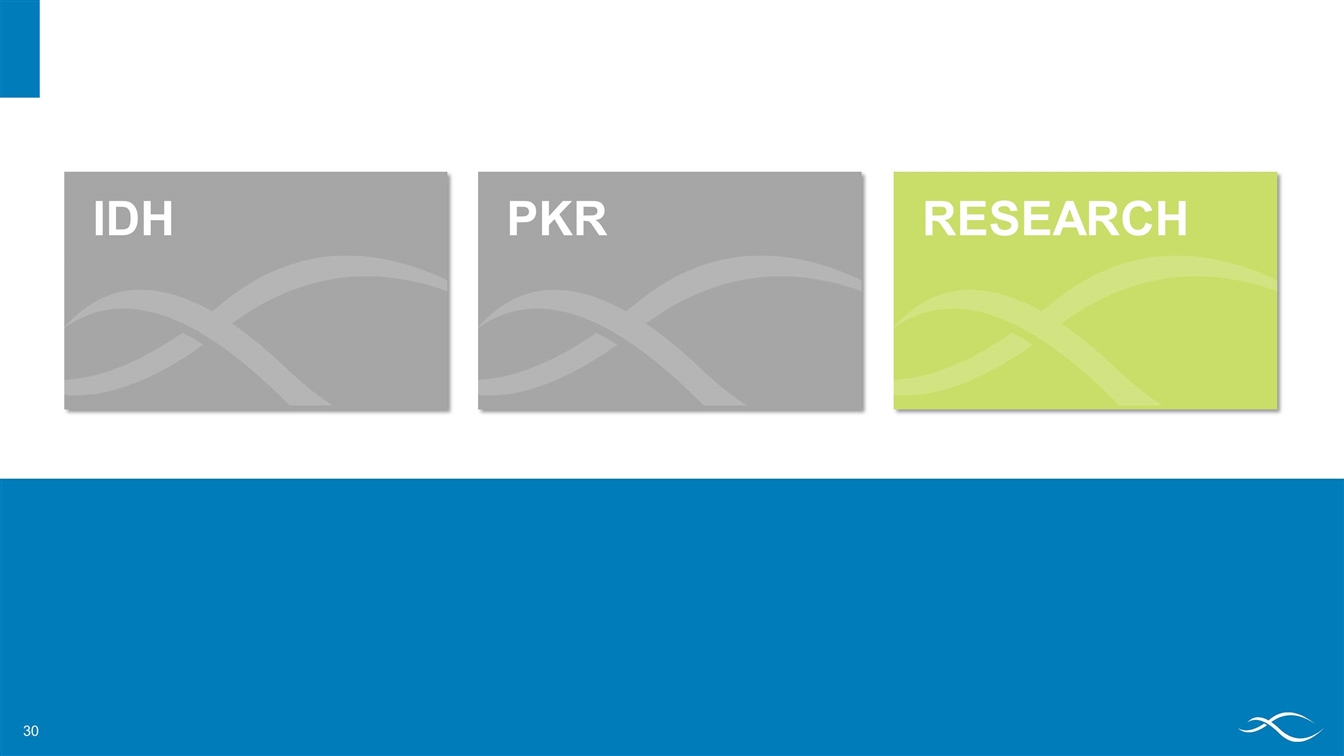
IDH PKR RESEARCH 30
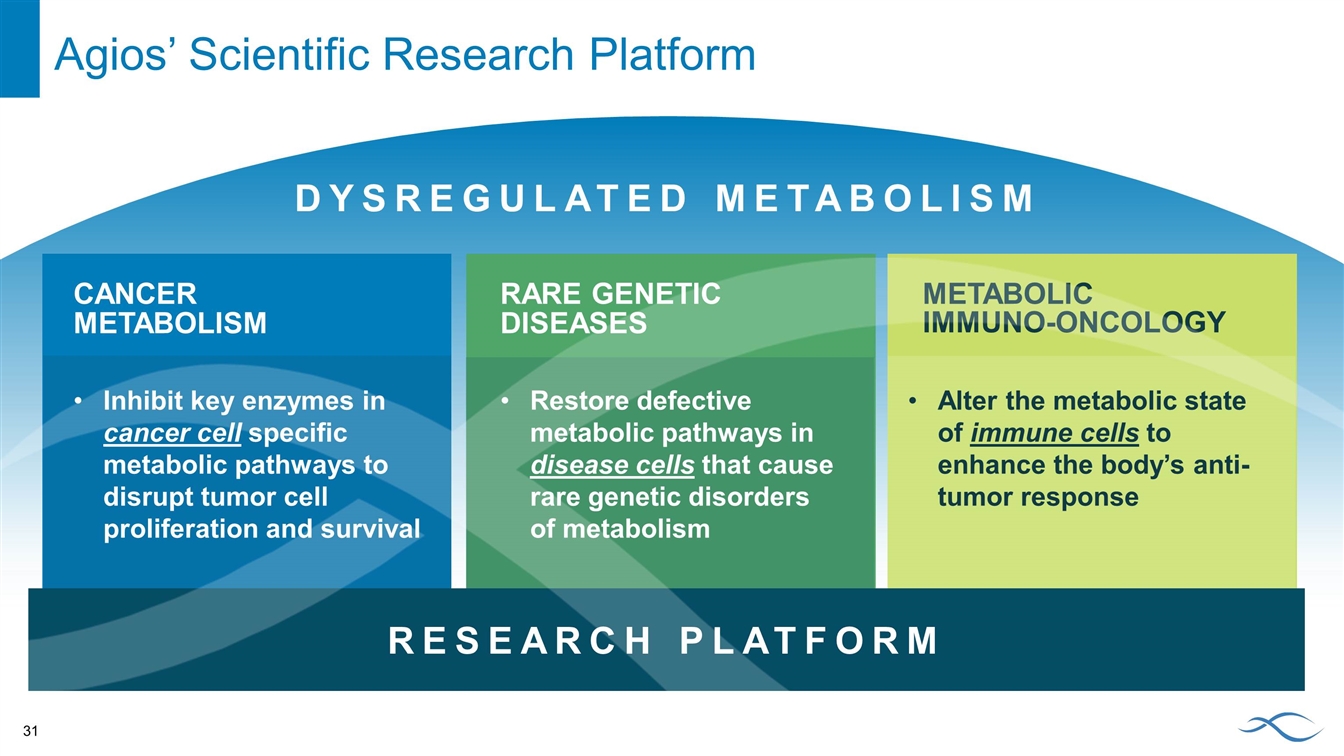
Agios’ Scientific Research Platform CANCER METABOLISM RARE GENETIC DISEASES METABOLIC IMMUNO-ONCOLOGY DYSREGULATED METABOLISM Inhibit key enzymes in cancer cell specific metabolic pathways to disrupt tumor cell proliferation and survival Restore defective metabolic pathways in disease cells that cause rare genetic disorders of metabolism Alter the metabolic state of immune cells to enhance the body’s anti-tumor response RESEARCH PLATFORM
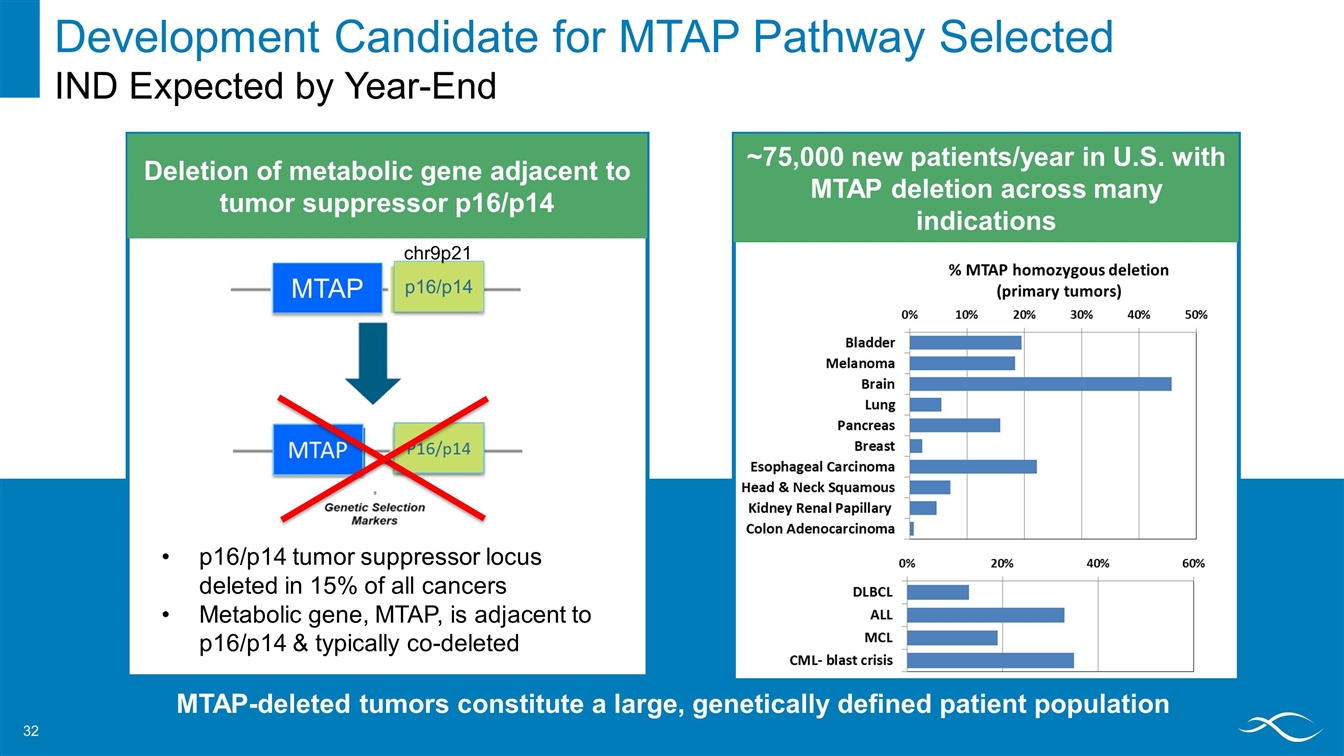
Development Candidate for MTAP Pathway Selected IND Expected by Year-End Deletion of metabolic gene adjacent to tumor suppressor p16/p14 p16/p14 tumor suppressor locus deleted in 15% of all cancers Metabolic gene, MTAP, is adjacent to p16/p14 & typically co-deleted MTAP p16/p14 MTAP-deleted tumors constitute a large, genetically defined patient population ~75,000 new patients/year in U.S. with MTAP deletion across many indications chr9p21
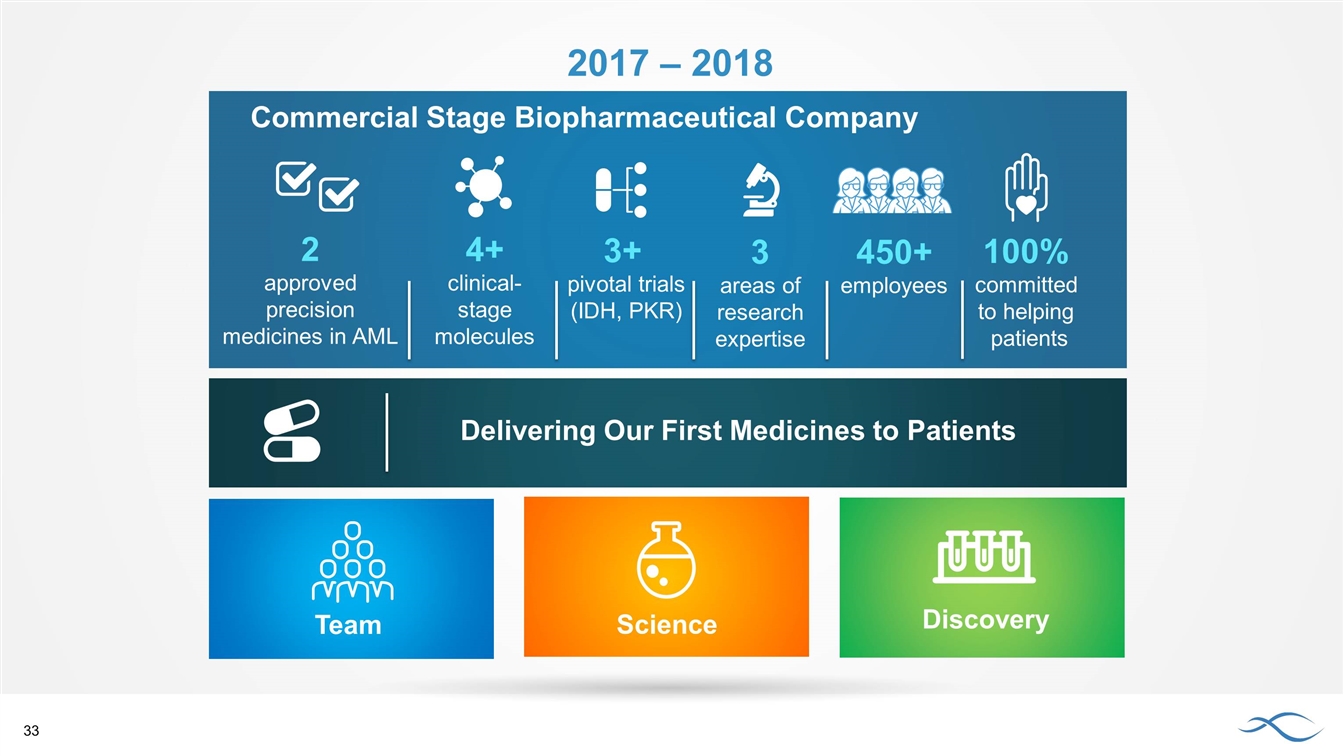
Delivering Our First Medicines to Patients Commercial Stage Biopharmaceutical Company Science Team Discovery 450+ employees 2 approved precision medicines in AML 2017 – 2018 4+ clinical-stage molecules 3+ pivotal trials (IDH, PKR) 100% committed to helping patients 3 areas of research expertise 33
































